What is Holistic Marketing and How To Achieve It
VerifiedAdded on 2022/08/15
|24
|6463
|15
AI Summary
about how holistic marketing practices contributes in causing an effect on consumer behavior for a particular organization
Contribute Materials
Your contribution can guide someone’s learning journey. Share your
documents today.
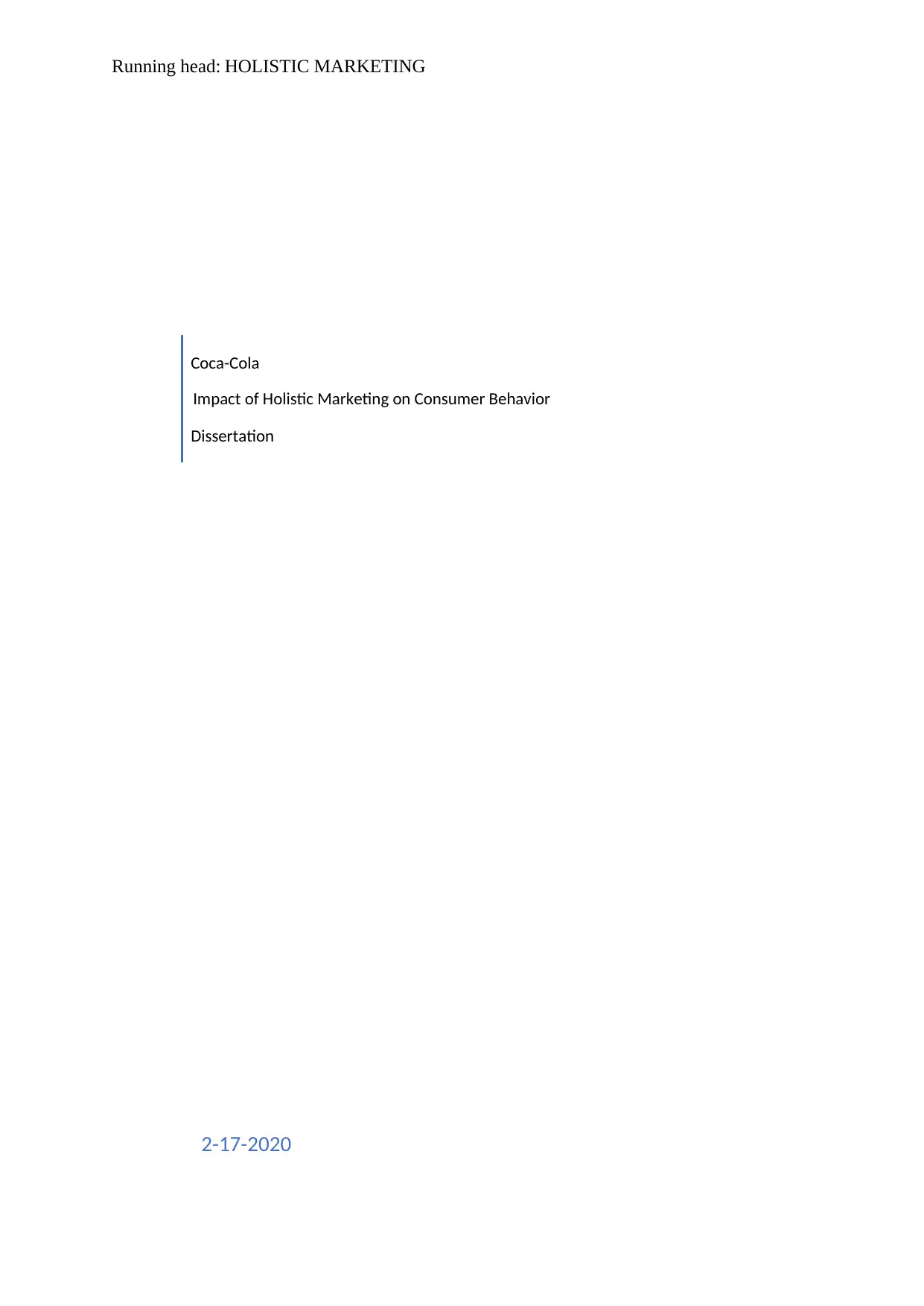
Running head: HOLISTIC MARKETING
Coca-Cola
Impact of Holistic Marketing on Consumer Behavior
Dissertation
2-17-2020
Coca-Cola
Impact of Holistic Marketing on Consumer Behavior
Dissertation
2-17-2020
Secure Best Marks with AI Grader
Need help grading? Try our AI Grader for instant feedback on your assignments.
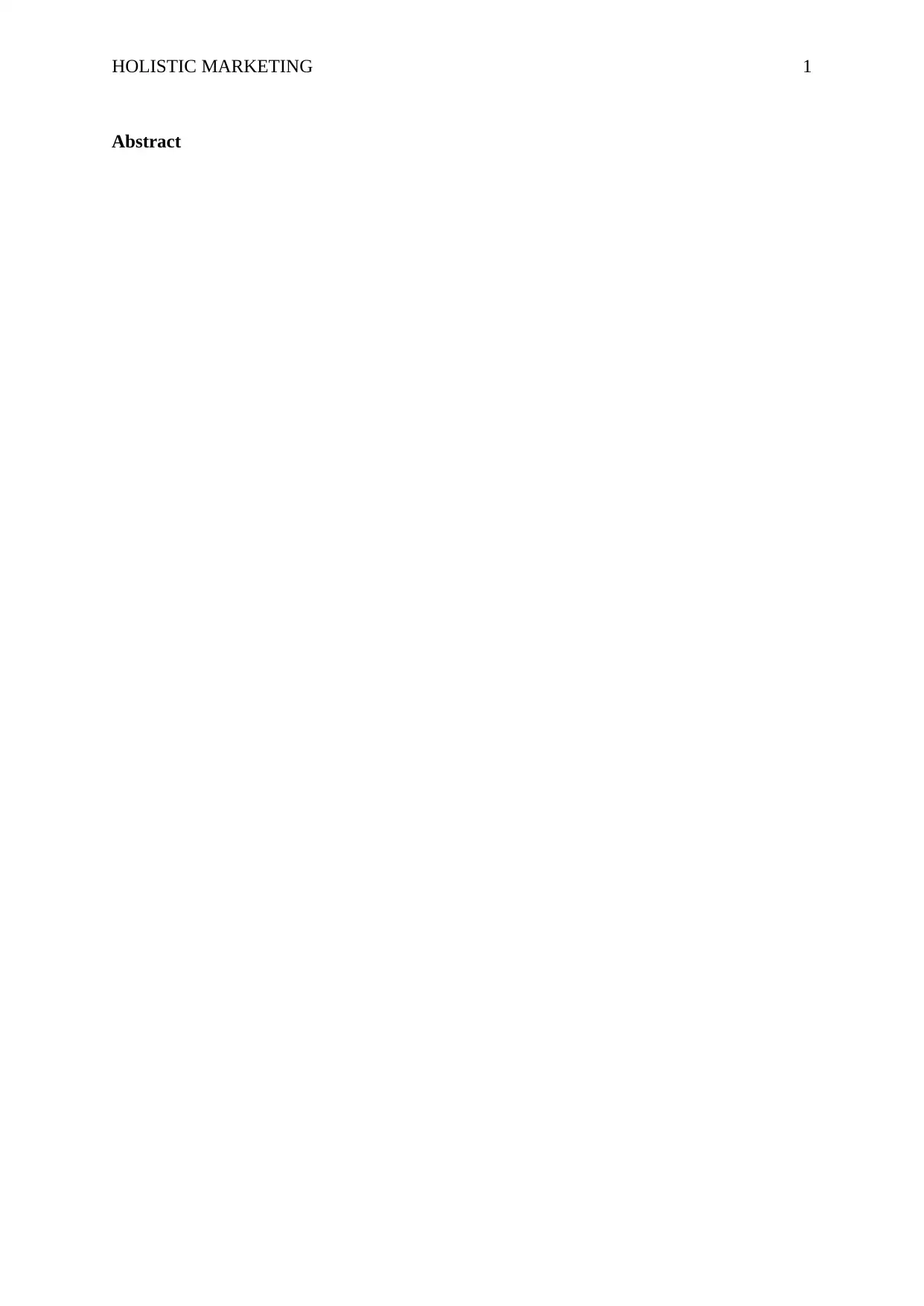
HOLISTIC MARKETING 1
Abstract
Abstract
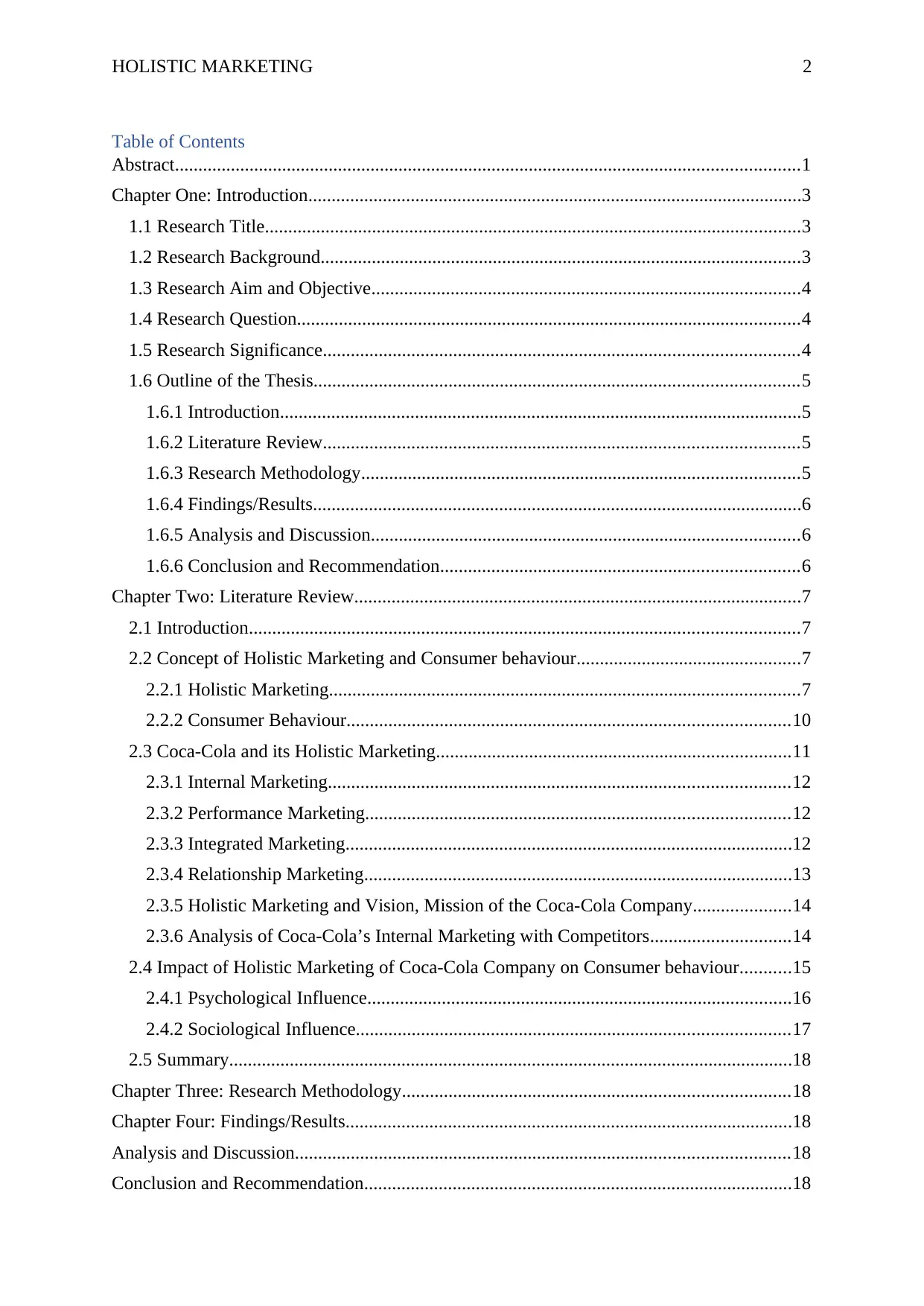
HOLISTIC MARKETING 2
Table of Contents
Abstract......................................................................................................................................1
Chapter One: Introduction..........................................................................................................3
1.1 Research Title...................................................................................................................3
1.2 Research Background.......................................................................................................3
1.3 Research Aim and Objective............................................................................................4
1.4 Research Question............................................................................................................4
1.5 Research Significance......................................................................................................4
1.6 Outline of the Thesis........................................................................................................5
1.6.1 Introduction................................................................................................................5
1.6.2 Literature Review......................................................................................................5
1.6.3 Research Methodology..............................................................................................5
1.6.4 Findings/Results.........................................................................................................6
1.6.5 Analysis and Discussion............................................................................................6
1.6.6 Conclusion and Recommendation.............................................................................6
Chapter Two: Literature Review................................................................................................7
2.1 Introduction......................................................................................................................7
2.2 Concept of Holistic Marketing and Consumer behaviour................................................7
2.2.1 Holistic Marketing.....................................................................................................7
2.2.2 Consumer Behaviour...............................................................................................10
2.3 Coca-Cola and its Holistic Marketing............................................................................11
2.3.1 Internal Marketing...................................................................................................12
2.3.2 Performance Marketing...........................................................................................12
2.3.3 Integrated Marketing................................................................................................12
2.3.4 Relationship Marketing............................................................................................13
2.3.5 Holistic Marketing and Vision, Mission of the Coca-Cola Company.....................14
2.3.6 Analysis of Coca-Cola’s Internal Marketing with Competitors..............................14
2.4 Impact of Holistic Marketing of Coca-Cola Company on Consumer behaviour...........15
2.4.1 Psychological Influence...........................................................................................16
2.4.2 Sociological Influence.............................................................................................17
2.5 Summary.........................................................................................................................18
Chapter Three: Research Methodology...................................................................................18
Chapter Four: Findings/Results................................................................................................18
Analysis and Discussion..........................................................................................................18
Conclusion and Recommendation............................................................................................18
Table of Contents
Abstract......................................................................................................................................1
Chapter One: Introduction..........................................................................................................3
1.1 Research Title...................................................................................................................3
1.2 Research Background.......................................................................................................3
1.3 Research Aim and Objective............................................................................................4
1.4 Research Question............................................................................................................4
1.5 Research Significance......................................................................................................4
1.6 Outline of the Thesis........................................................................................................5
1.6.1 Introduction................................................................................................................5
1.6.2 Literature Review......................................................................................................5
1.6.3 Research Methodology..............................................................................................5
1.6.4 Findings/Results.........................................................................................................6
1.6.5 Analysis and Discussion............................................................................................6
1.6.6 Conclusion and Recommendation.............................................................................6
Chapter Two: Literature Review................................................................................................7
2.1 Introduction......................................................................................................................7
2.2 Concept of Holistic Marketing and Consumer behaviour................................................7
2.2.1 Holistic Marketing.....................................................................................................7
2.2.2 Consumer Behaviour...............................................................................................10
2.3 Coca-Cola and its Holistic Marketing............................................................................11
2.3.1 Internal Marketing...................................................................................................12
2.3.2 Performance Marketing...........................................................................................12
2.3.3 Integrated Marketing................................................................................................12
2.3.4 Relationship Marketing............................................................................................13
2.3.5 Holistic Marketing and Vision, Mission of the Coca-Cola Company.....................14
2.3.6 Analysis of Coca-Cola’s Internal Marketing with Competitors..............................14
2.4 Impact of Holistic Marketing of Coca-Cola Company on Consumer behaviour...........15
2.4.1 Psychological Influence...........................................................................................16
2.4.2 Sociological Influence.............................................................................................17
2.5 Summary.........................................................................................................................18
Chapter Three: Research Methodology...................................................................................18
Chapter Four: Findings/Results................................................................................................18
Analysis and Discussion..........................................................................................................18
Conclusion and Recommendation............................................................................................18
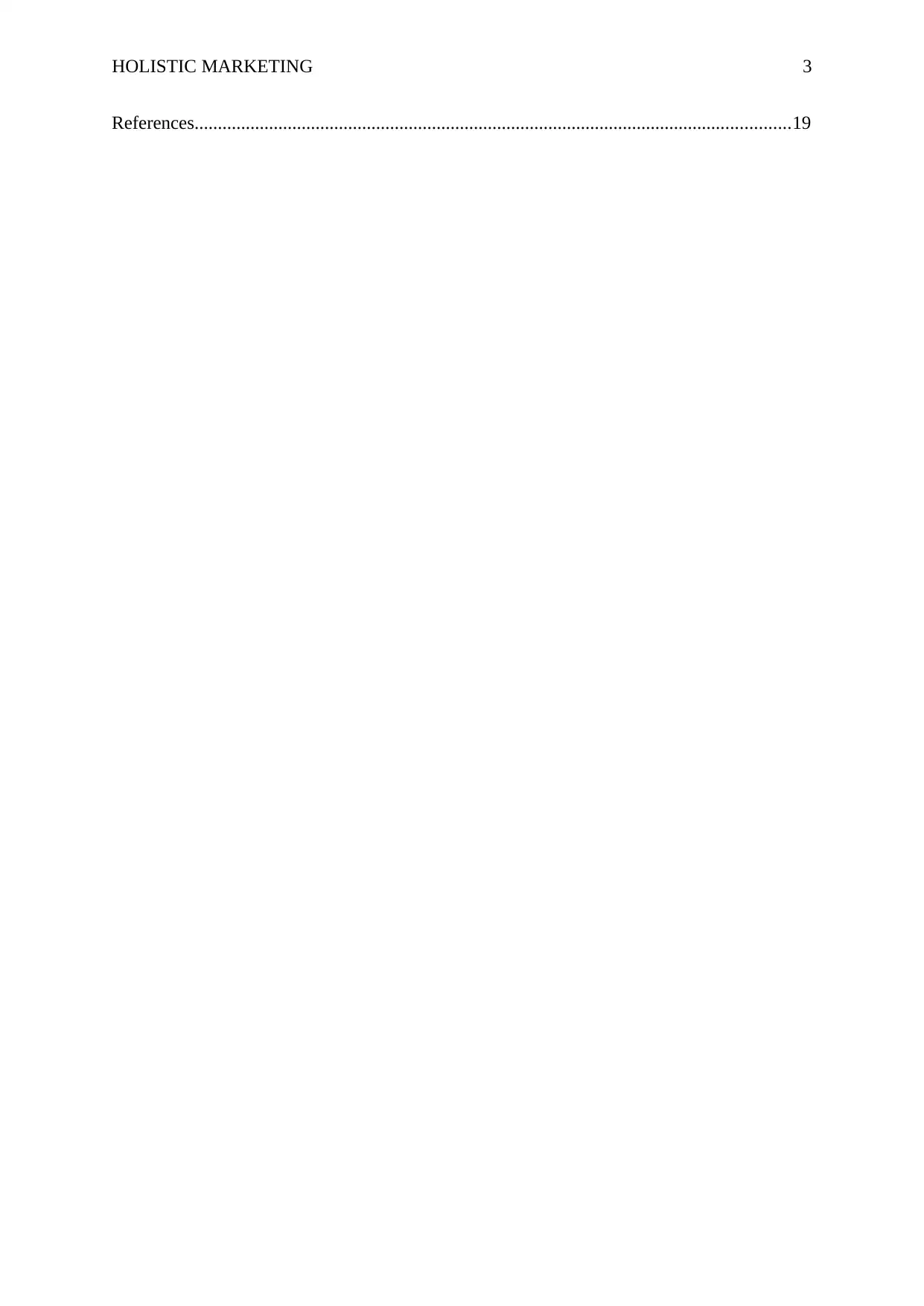
HOLISTIC MARKETING 3
References................................................................................................................................19
References................................................................................................................................19
Secure Best Marks with AI Grader
Need help grading? Try our AI Grader for instant feedback on your assignments.
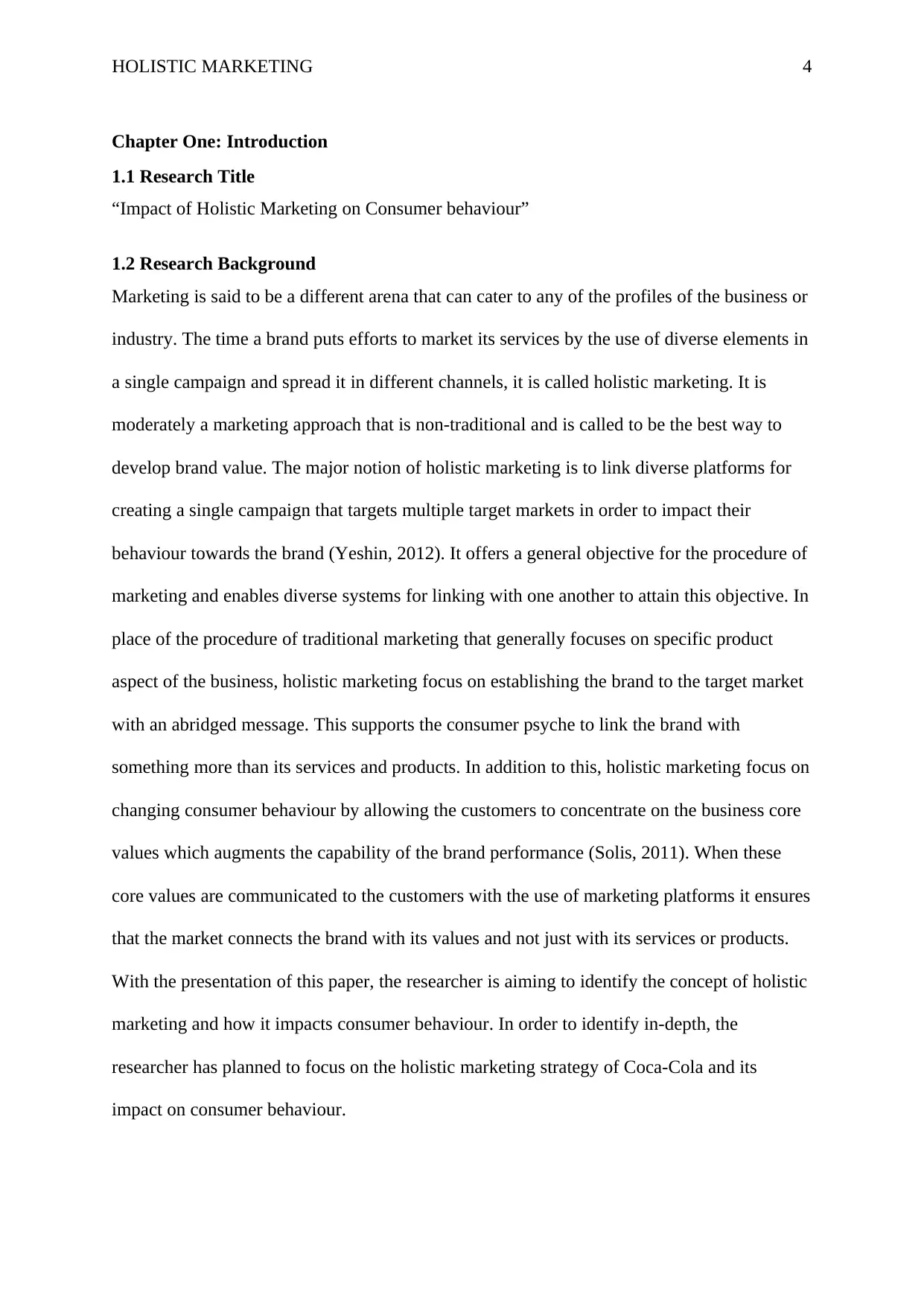
HOLISTIC MARKETING 4
Chapter One: Introduction
1.1 Research Title
“Impact of Holistic Marketing on Consumer behaviour”
1.2 Research Background
Marketing is said to be a different arena that can cater to any of the profiles of the business or
industry. The time a brand puts efforts to market its services by the use of diverse elements in
a single campaign and spread it in different channels, it is called holistic marketing. It is
moderately a marketing approach that is non-traditional and is called to be the best way to
develop brand value. The major notion of holistic marketing is to link diverse platforms for
creating a single campaign that targets multiple target markets in order to impact their
behaviour towards the brand (Yeshin, 2012). It offers a general objective for the procedure of
marketing and enables diverse systems for linking with one another to attain this objective. In
place of the procedure of traditional marketing that generally focuses on specific product
aspect of the business, holistic marketing focus on establishing the brand to the target market
with an abridged message. This supports the consumer psyche to link the brand with
something more than its services and products. In addition to this, holistic marketing focus on
changing consumer behaviour by allowing the customers to concentrate on the business core
values which augments the capability of the brand performance (Solis, 2011). When these
core values are communicated to the customers with the use of marketing platforms it ensures
that the market connects the brand with its values and not just with its services or products.
With the presentation of this paper, the researcher is aiming to identify the concept of holistic
marketing and how it impacts consumer behaviour. In order to identify in-depth, the
researcher has planned to focus on the holistic marketing strategy of Coca-Cola and its
impact on consumer behaviour.
Chapter One: Introduction
1.1 Research Title
“Impact of Holistic Marketing on Consumer behaviour”
1.2 Research Background
Marketing is said to be a different arena that can cater to any of the profiles of the business or
industry. The time a brand puts efforts to market its services by the use of diverse elements in
a single campaign and spread it in different channels, it is called holistic marketing. It is
moderately a marketing approach that is non-traditional and is called to be the best way to
develop brand value. The major notion of holistic marketing is to link diverse platforms for
creating a single campaign that targets multiple target markets in order to impact their
behaviour towards the brand (Yeshin, 2012). It offers a general objective for the procedure of
marketing and enables diverse systems for linking with one another to attain this objective. In
place of the procedure of traditional marketing that generally focuses on specific product
aspect of the business, holistic marketing focus on establishing the brand to the target market
with an abridged message. This supports the consumer psyche to link the brand with
something more than its services and products. In addition to this, holistic marketing focus on
changing consumer behaviour by allowing the customers to concentrate on the business core
values which augments the capability of the brand performance (Solis, 2011). When these
core values are communicated to the customers with the use of marketing platforms it ensures
that the market connects the brand with its values and not just with its services or products.
With the presentation of this paper, the researcher is aiming to identify the concept of holistic
marketing and how it impacts consumer behaviour. In order to identify in-depth, the
researcher has planned to focus on the holistic marketing strategy of Coca-Cola and its
impact on consumer behaviour.
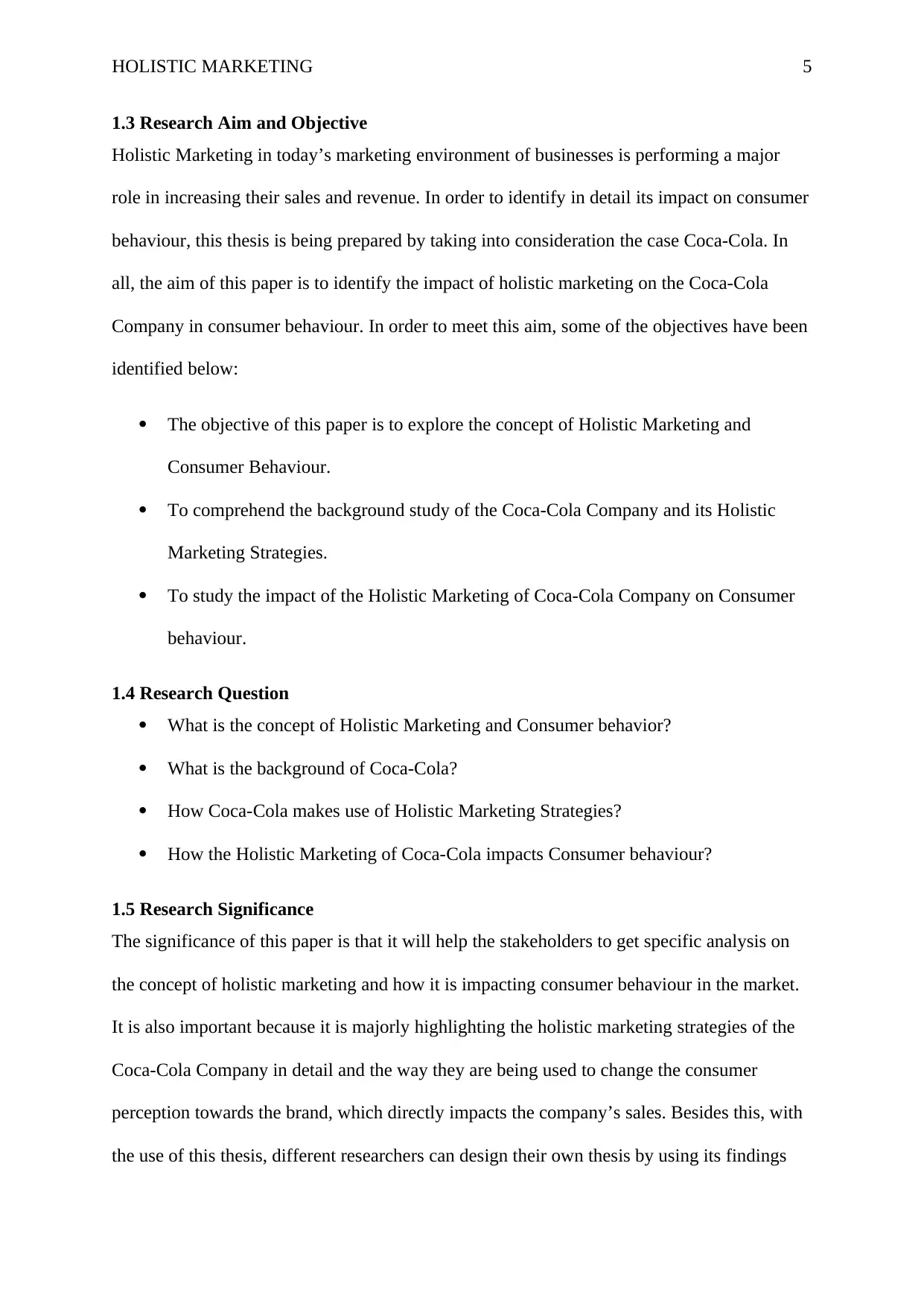
HOLISTIC MARKETING 5
1.3 Research Aim and Objective
Holistic Marketing in today’s marketing environment of businesses is performing a major
role in increasing their sales and revenue. In order to identify in detail its impact on consumer
behaviour, this thesis is being prepared by taking into consideration the case Coca-Cola. In
all, the aim of this paper is to identify the impact of holistic marketing on the Coca-Cola
Company in consumer behaviour. In order to meet this aim, some of the objectives have been
identified below:
The objective of this paper is to explore the concept of Holistic Marketing and
Consumer Behaviour.
To comprehend the background study of the Coca-Cola Company and its Holistic
Marketing Strategies.
To study the impact of the Holistic Marketing of Coca-Cola Company on Consumer
behaviour.
1.4 Research Question
What is the concept of Holistic Marketing and Consumer behavior?
What is the background of Coca-Cola?
How Coca-Cola makes use of Holistic Marketing Strategies?
How the Holistic Marketing of Coca-Cola impacts Consumer behaviour?
1.5 Research Significance
The significance of this paper is that it will help the stakeholders to get specific analysis on
the concept of holistic marketing and how it is impacting consumer behaviour in the market.
It is also important because it is majorly highlighting the holistic marketing strategies of the
Coca-Cola Company in detail and the way they are being used to change the consumer
perception towards the brand, which directly impacts the company’s sales. Besides this, with
the use of this thesis, different researchers can design their own thesis by using its findings
1.3 Research Aim and Objective
Holistic Marketing in today’s marketing environment of businesses is performing a major
role in increasing their sales and revenue. In order to identify in detail its impact on consumer
behaviour, this thesis is being prepared by taking into consideration the case Coca-Cola. In
all, the aim of this paper is to identify the impact of holistic marketing on the Coca-Cola
Company in consumer behaviour. In order to meet this aim, some of the objectives have been
identified below:
The objective of this paper is to explore the concept of Holistic Marketing and
Consumer Behaviour.
To comprehend the background study of the Coca-Cola Company and its Holistic
Marketing Strategies.
To study the impact of the Holistic Marketing of Coca-Cola Company on Consumer
behaviour.
1.4 Research Question
What is the concept of Holistic Marketing and Consumer behavior?
What is the background of Coca-Cola?
How Coca-Cola makes use of Holistic Marketing Strategies?
How the Holistic Marketing of Coca-Cola impacts Consumer behaviour?
1.5 Research Significance
The significance of this paper is that it will help the stakeholders to get specific analysis on
the concept of holistic marketing and how it is impacting consumer behaviour in the market.
It is also important because it is majorly highlighting the holistic marketing strategies of the
Coca-Cola Company in detail and the way they are being used to change the consumer
perception towards the brand, which directly impacts the company’s sales. Besides this, with
the use of this thesis, different researchers can design their own thesis by using its findings
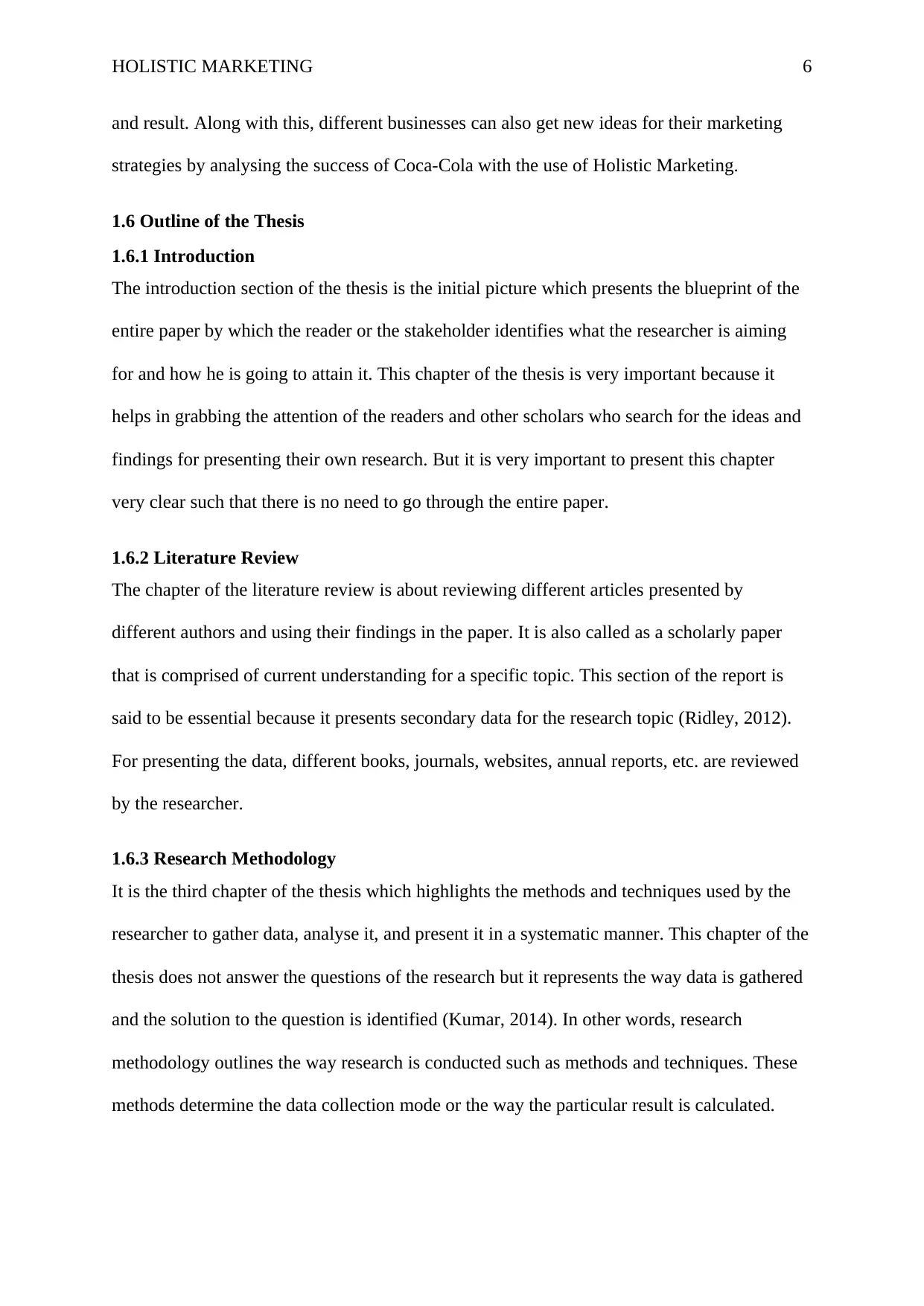
HOLISTIC MARKETING 6
and result. Along with this, different businesses can also get new ideas for their marketing
strategies by analysing the success of Coca-Cola with the use of Holistic Marketing.
1.6 Outline of the Thesis
1.6.1 Introduction
The introduction section of the thesis is the initial picture which presents the blueprint of the
entire paper by which the reader or the stakeholder identifies what the researcher is aiming
for and how he is going to attain it. This chapter of the thesis is very important because it
helps in grabbing the attention of the readers and other scholars who search for the ideas and
findings for presenting their own research. But it is very important to present this chapter
very clear such that there is no need to go through the entire paper.
1.6.2 Literature Review
The chapter of the literature review is about reviewing different articles presented by
different authors and using their findings in the paper. It is also called as a scholarly paper
that is comprised of current understanding for a specific topic. This section of the report is
said to be essential because it presents secondary data for the research topic (Ridley, 2012).
For presenting the data, different books, journals, websites, annual reports, etc. are reviewed
by the researcher.
1.6.3 Research Methodology
It is the third chapter of the thesis which highlights the methods and techniques used by the
researcher to gather data, analyse it, and present it in a systematic manner. This chapter of the
thesis does not answer the questions of the research but it represents the way data is gathered
and the solution to the question is identified (Kumar, 2014). In other words, research
methodology outlines the way research is conducted such as methods and techniques. These
methods determine the data collection mode or the way the particular result is calculated.
and result. Along with this, different businesses can also get new ideas for their marketing
strategies by analysing the success of Coca-Cola with the use of Holistic Marketing.
1.6 Outline of the Thesis
1.6.1 Introduction
The introduction section of the thesis is the initial picture which presents the blueprint of the
entire paper by which the reader or the stakeholder identifies what the researcher is aiming
for and how he is going to attain it. This chapter of the thesis is very important because it
helps in grabbing the attention of the readers and other scholars who search for the ideas and
findings for presenting their own research. But it is very important to present this chapter
very clear such that there is no need to go through the entire paper.
1.6.2 Literature Review
The chapter of the literature review is about reviewing different articles presented by
different authors and using their findings in the paper. It is also called as a scholarly paper
that is comprised of current understanding for a specific topic. This section of the report is
said to be essential because it presents secondary data for the research topic (Ridley, 2012).
For presenting the data, different books, journals, websites, annual reports, etc. are reviewed
by the researcher.
1.6.3 Research Methodology
It is the third chapter of the thesis which highlights the methods and techniques used by the
researcher to gather data, analyse it, and present it in a systematic manner. This chapter of the
thesis does not answer the questions of the research but it represents the way data is gathered
and the solution to the question is identified (Kumar, 2014). In other words, research
methodology outlines the way research is conducted such as methods and techniques. These
methods determine the data collection mode or the way the particular result is calculated.
Paraphrase This Document
Need a fresh take? Get an instant paraphrase of this document with our AI Paraphraser
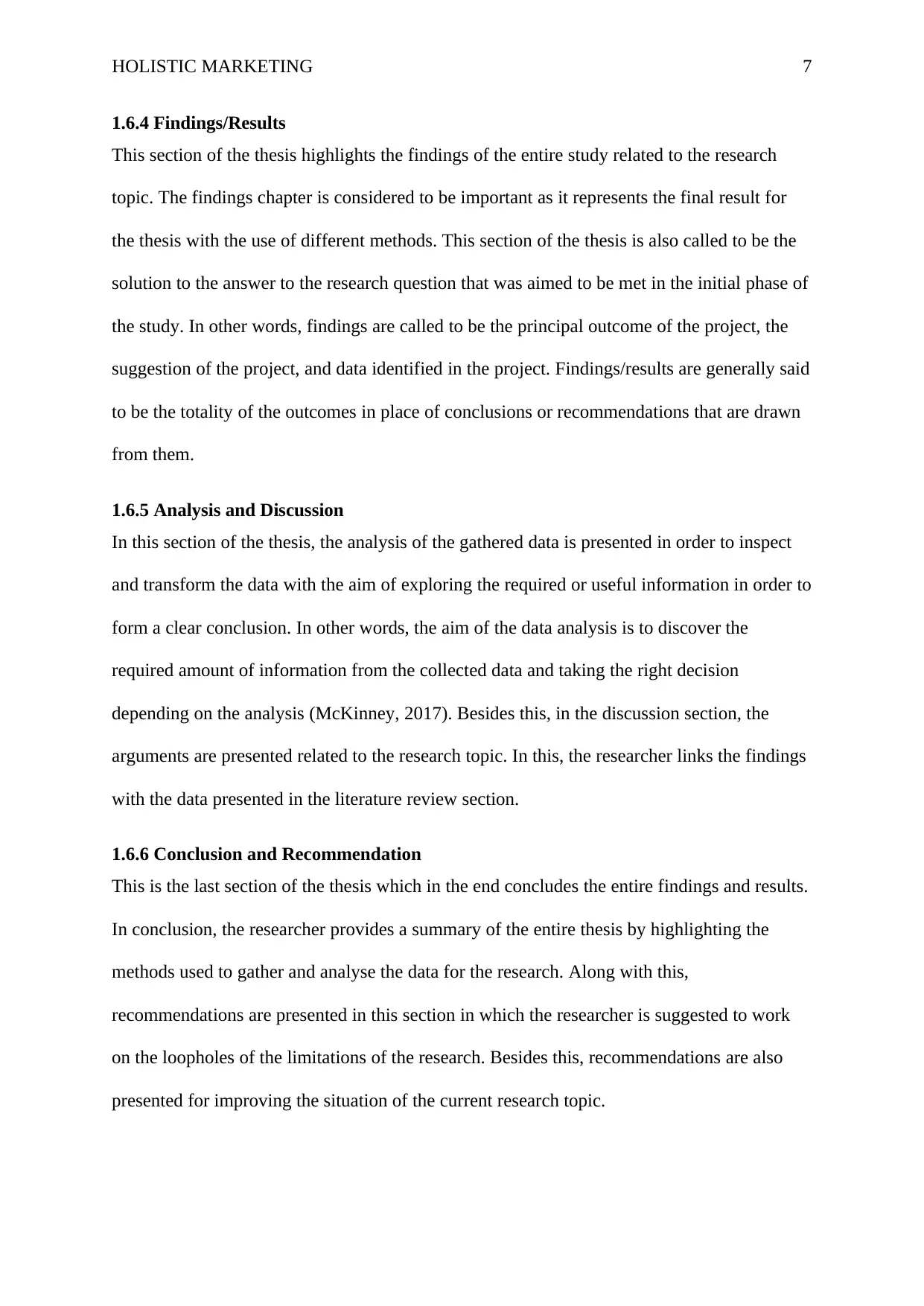
HOLISTIC MARKETING 7
1.6.4 Findings/Results
This section of the thesis highlights the findings of the entire study related to the research
topic. The findings chapter is considered to be important as it represents the final result for
the thesis with the use of different methods. This section of the thesis is also called to be the
solution to the answer to the research question that was aimed to be met in the initial phase of
the study. In other words, findings are called to be the principal outcome of the project, the
suggestion of the project, and data identified in the project. Findings/results are generally said
to be the totality of the outcomes in place of conclusions or recommendations that are drawn
from them.
1.6.5 Analysis and Discussion
In this section of the thesis, the analysis of the gathered data is presented in order to inspect
and transform the data with the aim of exploring the required or useful information in order to
form a clear conclusion. In other words, the aim of the data analysis is to discover the
required amount of information from the collected data and taking the right decision
depending on the analysis (McKinney, 2017). Besides this, in the discussion section, the
arguments are presented related to the research topic. In this, the researcher links the findings
with the data presented in the literature review section.
1.6.6 Conclusion and Recommendation
This is the last section of the thesis which in the end concludes the entire findings and results.
In conclusion, the researcher provides a summary of the entire thesis by highlighting the
methods used to gather and analyse the data for the research. Along with this,
recommendations are presented in this section in which the researcher is suggested to work
on the loopholes of the limitations of the research. Besides this, recommendations are also
presented for improving the situation of the current research topic.
1.6.4 Findings/Results
This section of the thesis highlights the findings of the entire study related to the research
topic. The findings chapter is considered to be important as it represents the final result for
the thesis with the use of different methods. This section of the thesis is also called to be the
solution to the answer to the research question that was aimed to be met in the initial phase of
the study. In other words, findings are called to be the principal outcome of the project, the
suggestion of the project, and data identified in the project. Findings/results are generally said
to be the totality of the outcomes in place of conclusions or recommendations that are drawn
from them.
1.6.5 Analysis and Discussion
In this section of the thesis, the analysis of the gathered data is presented in order to inspect
and transform the data with the aim of exploring the required or useful information in order to
form a clear conclusion. In other words, the aim of the data analysis is to discover the
required amount of information from the collected data and taking the right decision
depending on the analysis (McKinney, 2017). Besides this, in the discussion section, the
arguments are presented related to the research topic. In this, the researcher links the findings
with the data presented in the literature review section.
1.6.6 Conclusion and Recommendation
This is the last section of the thesis which in the end concludes the entire findings and results.
In conclusion, the researcher provides a summary of the entire thesis by highlighting the
methods used to gather and analyse the data for the research. Along with this,
recommendations are presented in this section in which the researcher is suggested to work
on the loopholes of the limitations of the research. Besides this, recommendations are also
presented for improving the situation of the current research topic.
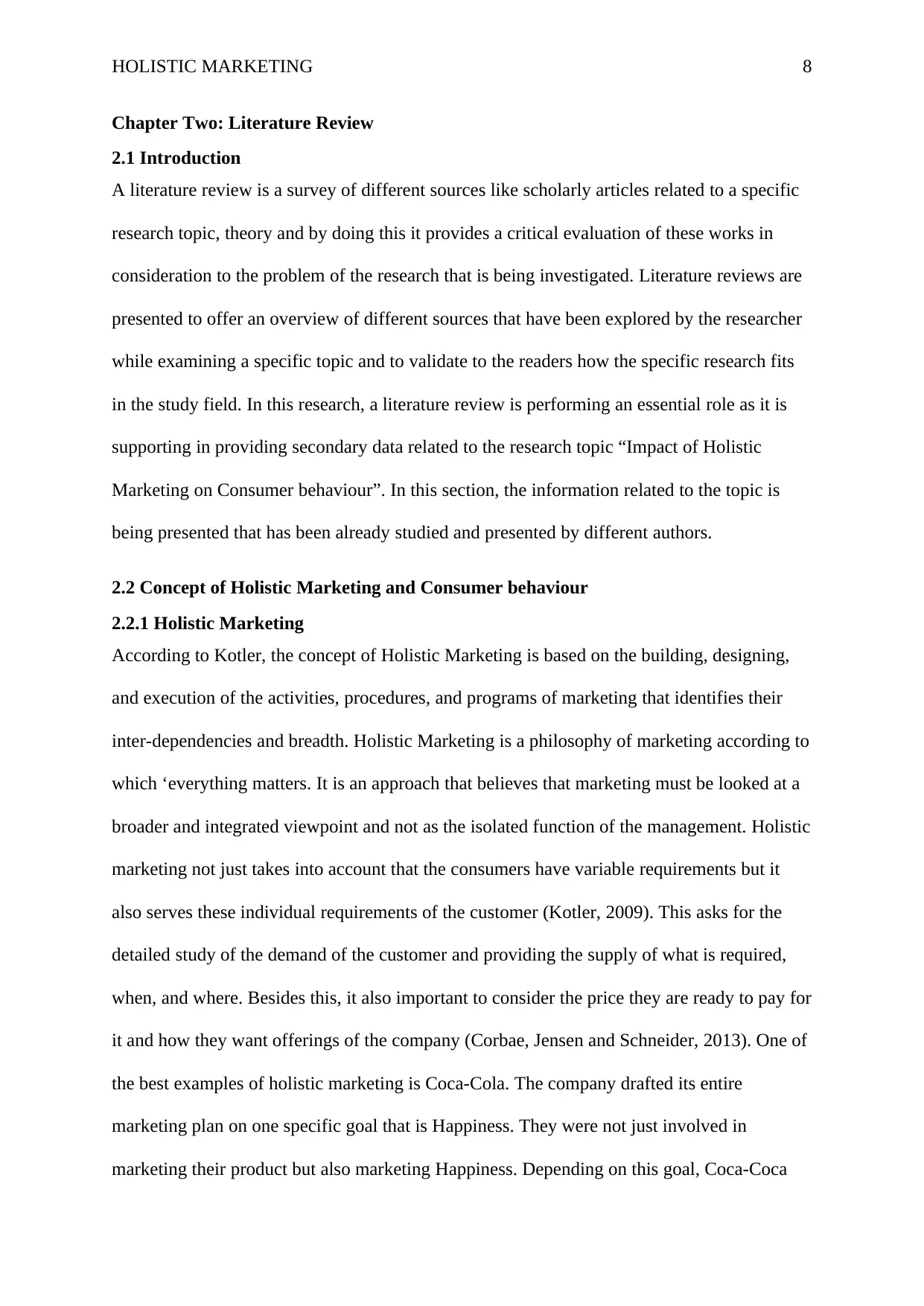
HOLISTIC MARKETING 8
Chapter Two: Literature Review
2.1 Introduction
A literature review is a survey of different sources like scholarly articles related to a specific
research topic, theory and by doing this it provides a critical evaluation of these works in
consideration to the problem of the research that is being investigated. Literature reviews are
presented to offer an overview of different sources that have been explored by the researcher
while examining a specific topic and to validate to the readers how the specific research fits
in the study field. In this research, a literature review is performing an essential role as it is
supporting in providing secondary data related to the research topic “Impact of Holistic
Marketing on Consumer behaviour”. In this section, the information related to the topic is
being presented that has been already studied and presented by different authors.
2.2 Concept of Holistic Marketing and Consumer behaviour
2.2.1 Holistic Marketing
According to Kotler, the concept of Holistic Marketing is based on the building, designing,
and execution of the activities, procedures, and programs of marketing that identifies their
inter-dependencies and breadth. Holistic Marketing is a philosophy of marketing according to
which ‘everything matters. It is an approach that believes that marketing must be looked at a
broader and integrated viewpoint and not as the isolated function of the management. Holistic
marketing not just takes into account that the consumers have variable requirements but it
also serves these individual requirements of the customer (Kotler, 2009). This asks for the
detailed study of the demand of the customer and providing the supply of what is required,
when, and where. Besides this, it also important to consider the price they are ready to pay for
it and how they want offerings of the company (Corbae, Jensen and Schneider, 2013). One of
the best examples of holistic marketing is Coca-Cola. The company drafted its entire
marketing plan on one specific goal that is Happiness. They were not just involved in
marketing their product but also marketing Happiness. Depending on this goal, Coca-Coca
Chapter Two: Literature Review
2.1 Introduction
A literature review is a survey of different sources like scholarly articles related to a specific
research topic, theory and by doing this it provides a critical evaluation of these works in
consideration to the problem of the research that is being investigated. Literature reviews are
presented to offer an overview of different sources that have been explored by the researcher
while examining a specific topic and to validate to the readers how the specific research fits
in the study field. In this research, a literature review is performing an essential role as it is
supporting in providing secondary data related to the research topic “Impact of Holistic
Marketing on Consumer behaviour”. In this section, the information related to the topic is
being presented that has been already studied and presented by different authors.
2.2 Concept of Holistic Marketing and Consumer behaviour
2.2.1 Holistic Marketing
According to Kotler, the concept of Holistic Marketing is based on the building, designing,
and execution of the activities, procedures, and programs of marketing that identifies their
inter-dependencies and breadth. Holistic Marketing is a philosophy of marketing according to
which ‘everything matters. It is an approach that believes that marketing must be looked at a
broader and integrated viewpoint and not as the isolated function of the management. Holistic
marketing not just takes into account that the consumers have variable requirements but it
also serves these individual requirements of the customer (Kotler, 2009). This asks for the
detailed study of the demand of the customer and providing the supply of what is required,
when, and where. Besides this, it also important to consider the price they are ready to pay for
it and how they want offerings of the company (Corbae, Jensen and Schneider, 2013). One of
the best examples of holistic marketing is Coca-Cola. The company drafted its entire
marketing plan on one specific goal that is Happiness. They were not just involved in
marketing their product but also marketing Happiness. Depending on this goal, Coca-Coca
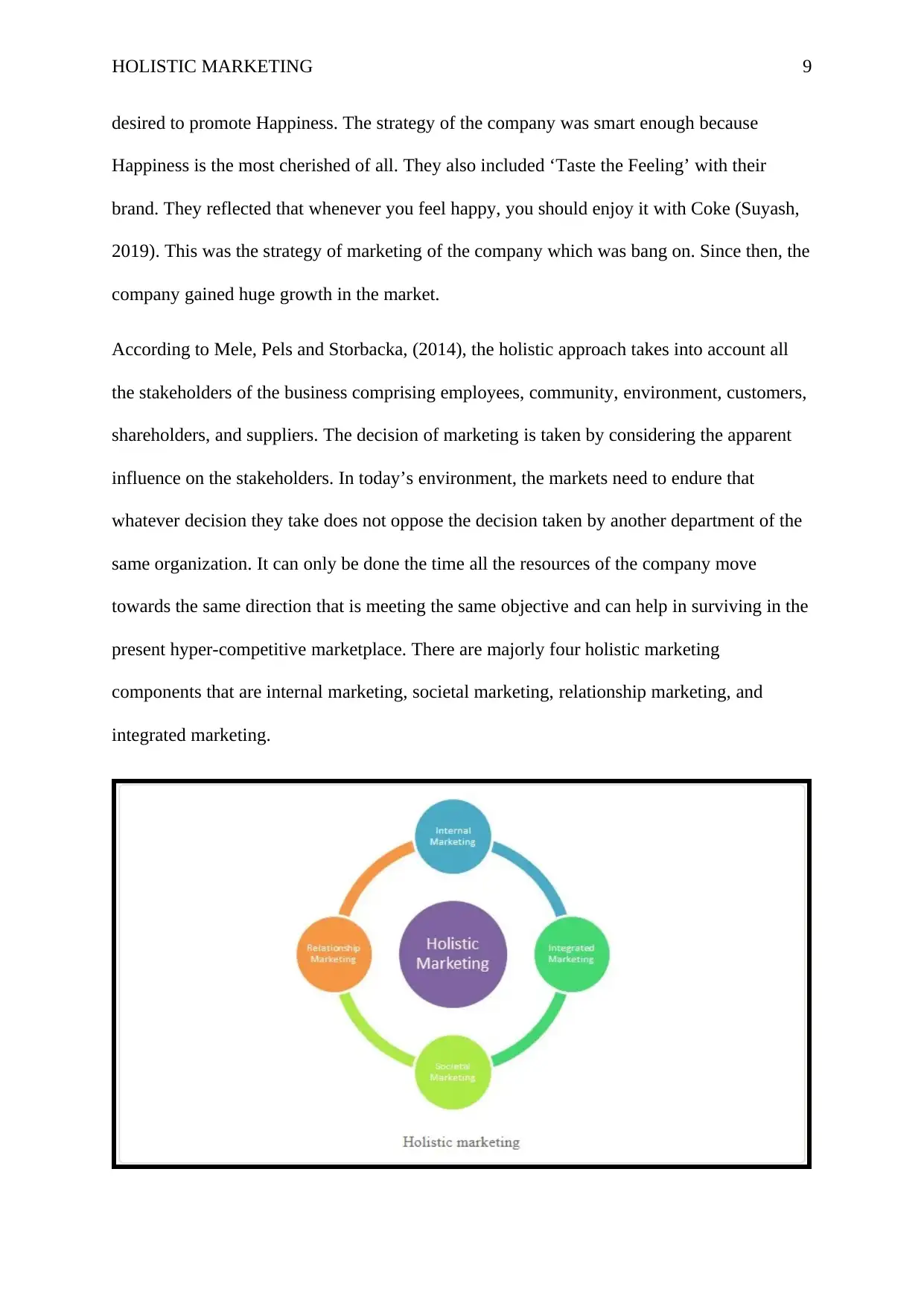
HOLISTIC MARKETING 9
desired to promote Happiness. The strategy of the company was smart enough because
Happiness is the most cherished of all. They also included ‘Taste the Feeling’ with their
brand. They reflected that whenever you feel happy, you should enjoy it with Coke (Suyash,
2019). This was the strategy of marketing of the company which was bang on. Since then, the
company gained huge growth in the market.
According to Mele, Pels and Storbacka, (2014), the holistic approach takes into account all
the stakeholders of the business comprising employees, community, environment, customers,
shareholders, and suppliers. The decision of marketing is taken by considering the apparent
influence on the stakeholders. In today’s environment, the markets need to endure that
whatever decision they take does not oppose the decision taken by another department of the
same organization. It can only be done the time all the resources of the company move
towards the same direction that is meeting the same objective and can help in surviving in the
present hyper-competitive marketplace. There are majorly four holistic marketing
components that are internal marketing, societal marketing, relationship marketing, and
integrated marketing.
desired to promote Happiness. The strategy of the company was smart enough because
Happiness is the most cherished of all. They also included ‘Taste the Feeling’ with their
brand. They reflected that whenever you feel happy, you should enjoy it with Coke (Suyash,
2019). This was the strategy of marketing of the company which was bang on. Since then, the
company gained huge growth in the market.
According to Mele, Pels and Storbacka, (2014), the holistic approach takes into account all
the stakeholders of the business comprising employees, community, environment, customers,
shareholders, and suppliers. The decision of marketing is taken by considering the apparent
influence on the stakeholders. In today’s environment, the markets need to endure that
whatever decision they take does not oppose the decision taken by another department of the
same organization. It can only be done the time all the resources of the company move
towards the same direction that is meeting the same objective and can help in surviving in the
present hyper-competitive marketplace. There are majorly four holistic marketing
components that are internal marketing, societal marketing, relationship marketing, and
integrated marketing.
Secure Best Marks with AI Grader
Need help grading? Try our AI Grader for instant feedback on your assignments.
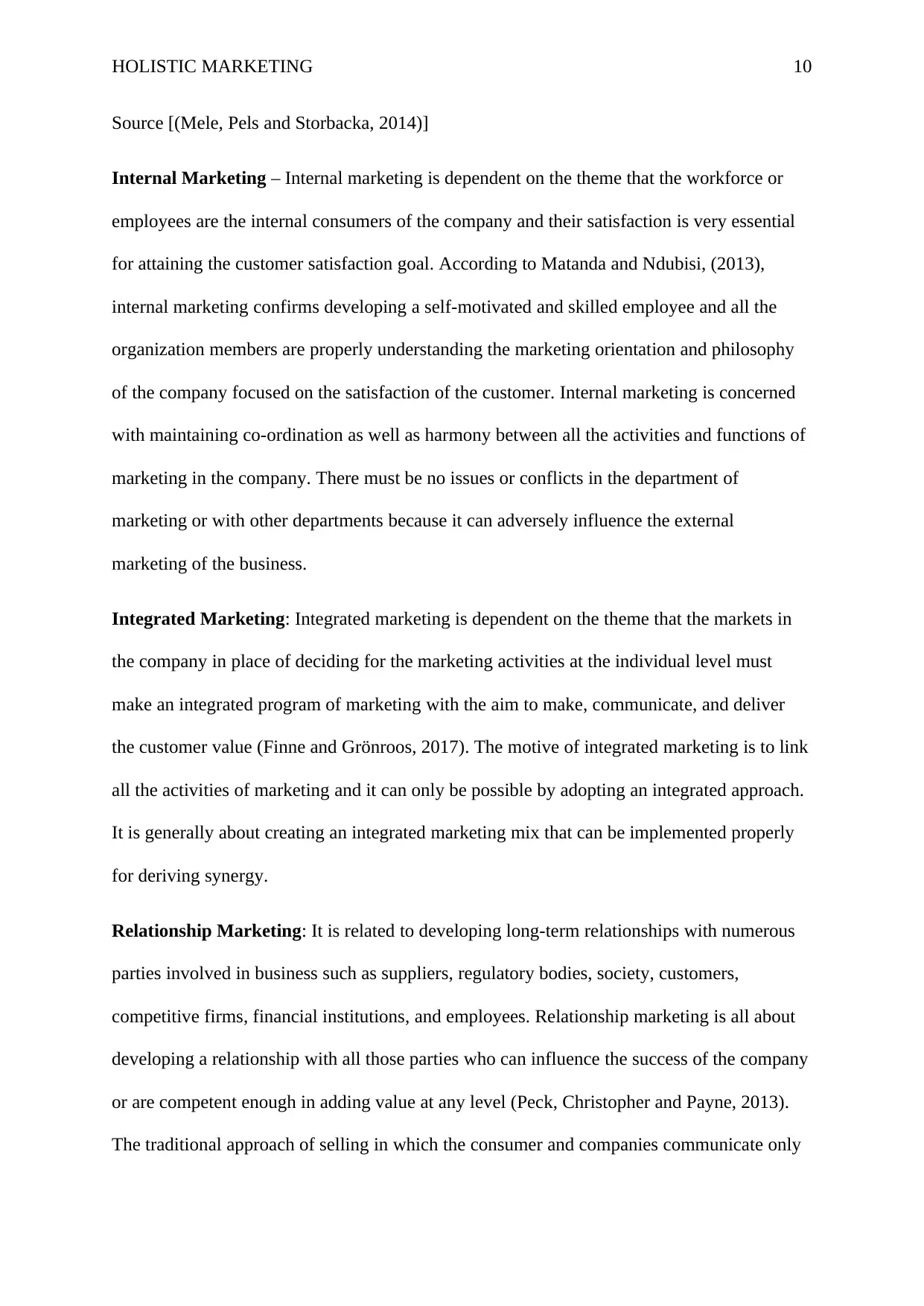
HOLISTIC MARKETING 10
Source [(Mele, Pels and Storbacka, 2014)]
Internal Marketing – Internal marketing is dependent on the theme that the workforce or
employees are the internal consumers of the company and their satisfaction is very essential
for attaining the customer satisfaction goal. According to Matanda and Ndubisi, (2013),
internal marketing confirms developing a self-motivated and skilled employee and all the
organization members are properly understanding the marketing orientation and philosophy
of the company focused on the satisfaction of the customer. Internal marketing is concerned
with maintaining co-ordination as well as harmony between all the activities and functions of
marketing in the company. There must be no issues or conflicts in the department of
marketing or with other departments because it can adversely influence the external
marketing of the business.
Integrated Marketing: Integrated marketing is dependent on the theme that the markets in
the company in place of deciding for the marketing activities at the individual level must
make an integrated program of marketing with the aim to make, communicate, and deliver
the customer value (Finne and Grönroos, 2017). The motive of integrated marketing is to link
all the activities of marketing and it can only be possible by adopting an integrated approach.
It is generally about creating an integrated marketing mix that can be implemented properly
for deriving synergy.
Relationship Marketing: It is related to developing long-term relationships with numerous
parties involved in business such as suppliers, regulatory bodies, society, customers,
competitive firms, financial institutions, and employees. Relationship marketing is all about
developing a relationship with all those parties who can influence the success of the company
or are competent enough in adding value at any level (Peck, Christopher and Payne, 2013).
The traditional approach of selling in which the consumer and companies communicate only
Source [(Mele, Pels and Storbacka, 2014)]
Internal Marketing – Internal marketing is dependent on the theme that the workforce or
employees are the internal consumers of the company and their satisfaction is very essential
for attaining the customer satisfaction goal. According to Matanda and Ndubisi, (2013),
internal marketing confirms developing a self-motivated and skilled employee and all the
organization members are properly understanding the marketing orientation and philosophy
of the company focused on the satisfaction of the customer. Internal marketing is concerned
with maintaining co-ordination as well as harmony between all the activities and functions of
marketing in the company. There must be no issues or conflicts in the department of
marketing or with other departments because it can adversely influence the external
marketing of the business.
Integrated Marketing: Integrated marketing is dependent on the theme that the markets in
the company in place of deciding for the marketing activities at the individual level must
make an integrated program of marketing with the aim to make, communicate, and deliver
the customer value (Finne and Grönroos, 2017). The motive of integrated marketing is to link
all the activities of marketing and it can only be possible by adopting an integrated approach.
It is generally about creating an integrated marketing mix that can be implemented properly
for deriving synergy.
Relationship Marketing: It is related to developing long-term relationships with numerous
parties involved in business such as suppliers, regulatory bodies, society, customers,
competitive firms, financial institutions, and employees. Relationship marketing is all about
developing a relationship with all those parties who can influence the success of the company
or are competent enough in adding value at any level (Peck, Christopher and Payne, 2013).
The traditional approach of selling in which the consumer and companies communicate only
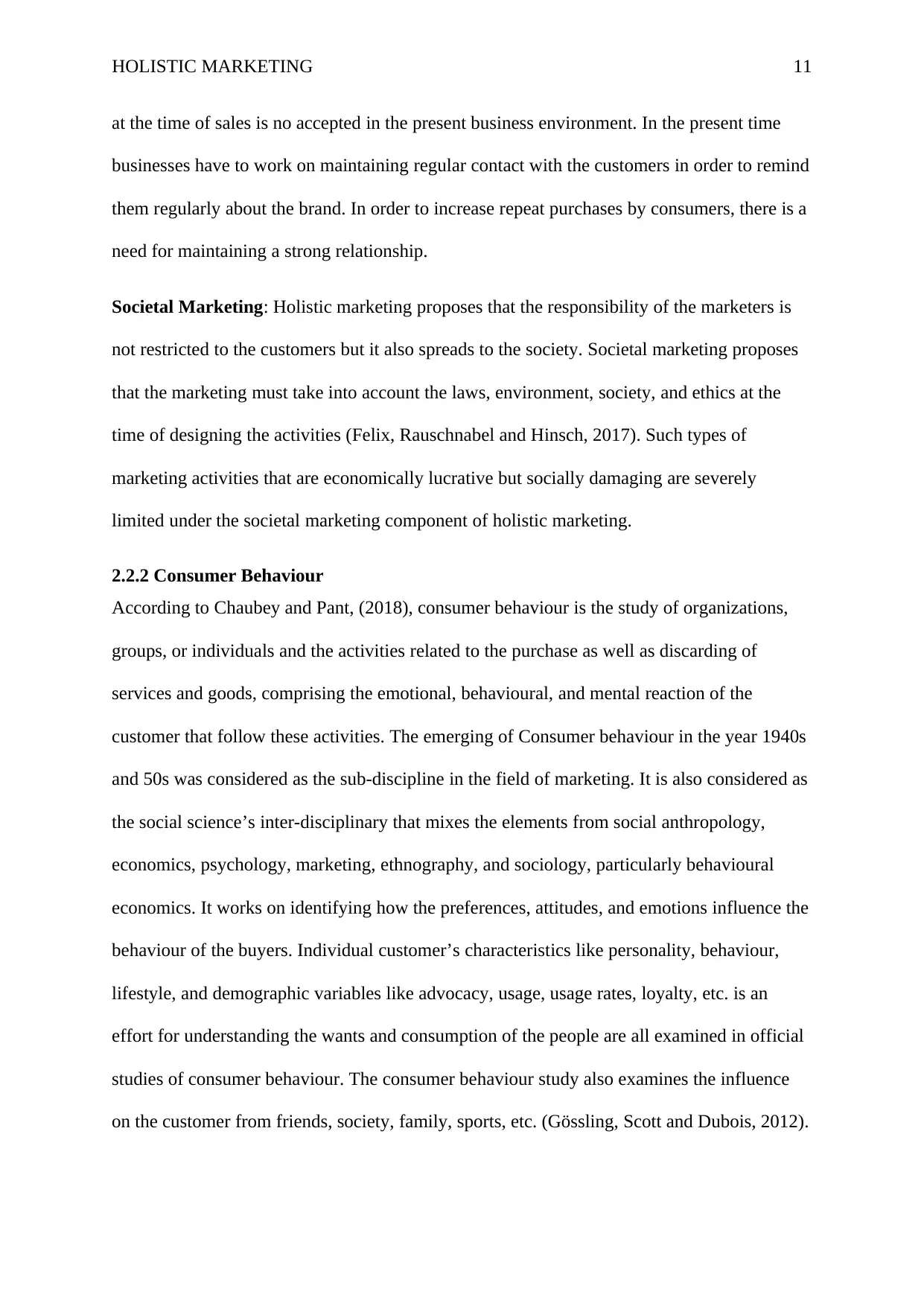
HOLISTIC MARKETING 11
at the time of sales is no accepted in the present business environment. In the present time
businesses have to work on maintaining regular contact with the customers in order to remind
them regularly about the brand. In order to increase repeat purchases by consumers, there is a
need for maintaining a strong relationship.
Societal Marketing: Holistic marketing proposes that the responsibility of the marketers is
not restricted to the customers but it also spreads to the society. Societal marketing proposes
that the marketing must take into account the laws, environment, society, and ethics at the
time of designing the activities (Felix, Rauschnabel and Hinsch, 2017). Such types of
marketing activities that are economically lucrative but socially damaging are severely
limited under the societal marketing component of holistic marketing.
2.2.2 Consumer Behaviour
According to Chaubey and Pant, (2018), consumer behaviour is the study of organizations,
groups, or individuals and the activities related to the purchase as well as discarding of
services and goods, comprising the emotional, behavioural, and mental reaction of the
customer that follow these activities. The emerging of Consumer behaviour in the year 1940s
and 50s was considered as the sub-discipline in the field of marketing. It is also considered as
the social science’s inter-disciplinary that mixes the elements from social anthropology,
economics, psychology, marketing, ethnography, and sociology, particularly behavioural
economics. It works on identifying how the preferences, attitudes, and emotions influence the
behaviour of the buyers. Individual customer’s characteristics like personality, behaviour,
lifestyle, and demographic variables like advocacy, usage, usage rates, loyalty, etc. is an
effort for understanding the wants and consumption of the people are all examined in official
studies of consumer behaviour. The consumer behaviour study also examines the influence
on the customer from friends, society, family, sports, etc. (Gössling, Scott and Dubois, 2012).
at the time of sales is no accepted in the present business environment. In the present time
businesses have to work on maintaining regular contact with the customers in order to remind
them regularly about the brand. In order to increase repeat purchases by consumers, there is a
need for maintaining a strong relationship.
Societal Marketing: Holistic marketing proposes that the responsibility of the marketers is
not restricted to the customers but it also spreads to the society. Societal marketing proposes
that the marketing must take into account the laws, environment, society, and ethics at the
time of designing the activities (Felix, Rauschnabel and Hinsch, 2017). Such types of
marketing activities that are economically lucrative but socially damaging are severely
limited under the societal marketing component of holistic marketing.
2.2.2 Consumer Behaviour
According to Chaubey and Pant, (2018), consumer behaviour is the study of organizations,
groups, or individuals and the activities related to the purchase as well as discarding of
services and goods, comprising the emotional, behavioural, and mental reaction of the
customer that follow these activities. The emerging of Consumer behaviour in the year 1940s
and 50s was considered as the sub-discipline in the field of marketing. It is also considered as
the social science’s inter-disciplinary that mixes the elements from social anthropology,
economics, psychology, marketing, ethnography, and sociology, particularly behavioural
economics. It works on identifying how the preferences, attitudes, and emotions influence the
behaviour of the buyers. Individual customer’s characteristics like personality, behaviour,
lifestyle, and demographic variables like advocacy, usage, usage rates, loyalty, etc. is an
effort for understanding the wants and consumption of the people are all examined in official
studies of consumer behaviour. The consumer behaviour study also examines the influence
on the customer from friends, society, family, sports, etc. (Gössling, Scott and Dubois, 2012).
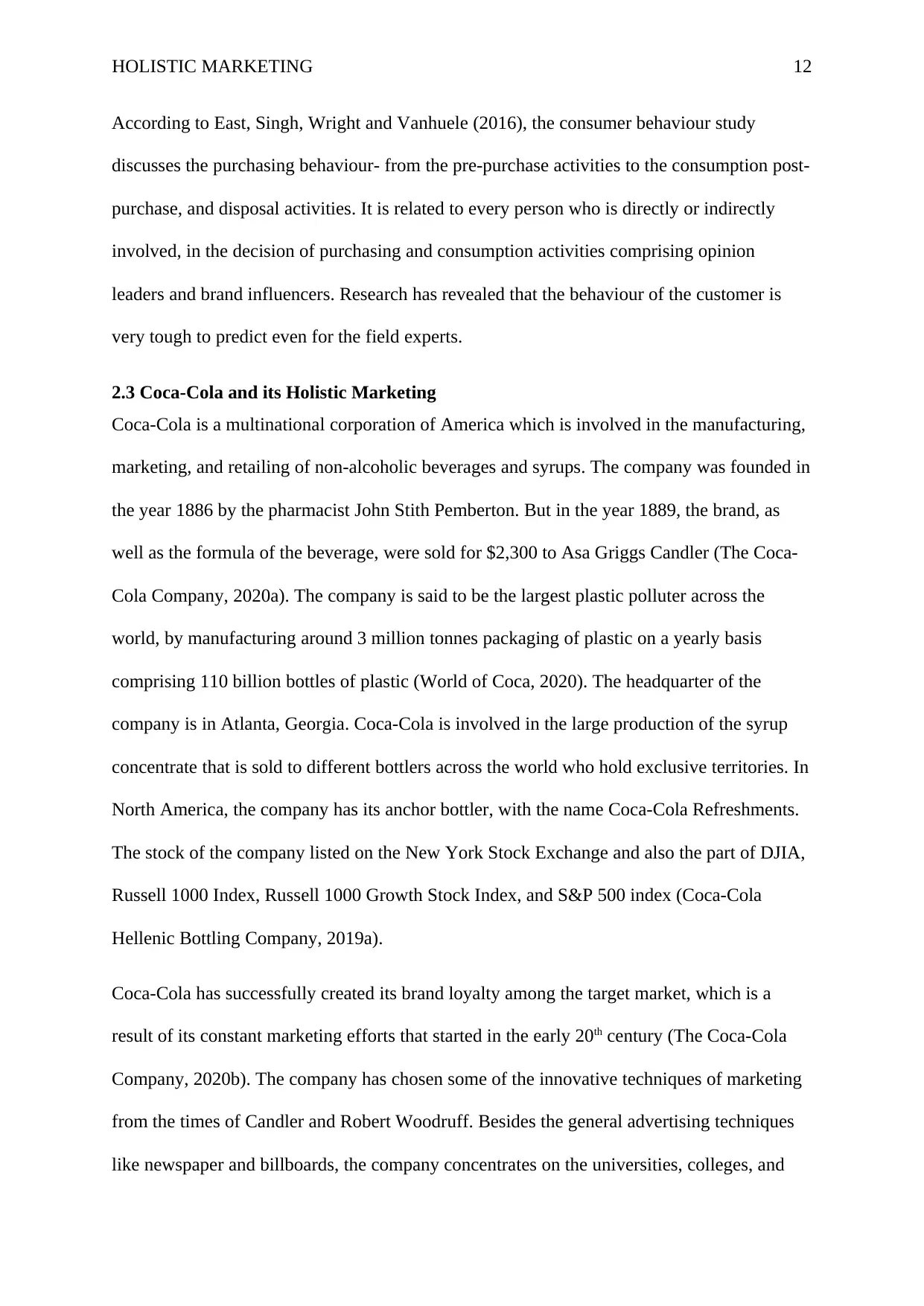
HOLISTIC MARKETING 12
According to East, Singh, Wright and Vanhuele (2016), the consumer behaviour study
discusses the purchasing behaviour- from the pre-purchase activities to the consumption post-
purchase, and disposal activities. It is related to every person who is directly or indirectly
involved, in the decision of purchasing and consumption activities comprising opinion
leaders and brand influencers. Research has revealed that the behaviour of the customer is
very tough to predict even for the field experts.
2.3 Coca-Cola and its Holistic Marketing
Coca-Cola is a multinational corporation of America which is involved in the manufacturing,
marketing, and retailing of non-alcoholic beverages and syrups. The company was founded in
the year 1886 by the pharmacist John Stith Pemberton. But in the year 1889, the brand, as
well as the formula of the beverage, were sold for $2,300 to Asa Griggs Candler (The Coca-
Cola Company, 2020a). The company is said to be the largest plastic polluter across the
world, by manufacturing around 3 million tonnes packaging of plastic on a yearly basis
comprising 110 billion bottles of plastic (World of Coca, 2020). The headquarter of the
company is in Atlanta, Georgia. Coca-Cola is involved in the large production of the syrup
concentrate that is sold to different bottlers across the world who hold exclusive territories. In
North America, the company has its anchor bottler, with the name Coca-Cola Refreshments.
The stock of the company listed on the New York Stock Exchange and also the part of DJIA,
Russell 1000 Index, Russell 1000 Growth Stock Index, and S&P 500 index (Coca-Cola
Hellenic Bottling Company, 2019a).
Coca-Cola has successfully created its brand loyalty among the target market, which is a
result of its constant marketing efforts that started in the early 20th century (The Coca-Cola
Company, 2020b). The company has chosen some of the innovative techniques of marketing
from the times of Candler and Robert Woodruff. Besides the general advertising techniques
like newspaper and billboards, the company concentrates on the universities, colleges, and
According to East, Singh, Wright and Vanhuele (2016), the consumer behaviour study
discusses the purchasing behaviour- from the pre-purchase activities to the consumption post-
purchase, and disposal activities. It is related to every person who is directly or indirectly
involved, in the decision of purchasing and consumption activities comprising opinion
leaders and brand influencers. Research has revealed that the behaviour of the customer is
very tough to predict even for the field experts.
2.3 Coca-Cola and its Holistic Marketing
Coca-Cola is a multinational corporation of America which is involved in the manufacturing,
marketing, and retailing of non-alcoholic beverages and syrups. The company was founded in
the year 1886 by the pharmacist John Stith Pemberton. But in the year 1889, the brand, as
well as the formula of the beverage, were sold for $2,300 to Asa Griggs Candler (The Coca-
Cola Company, 2020a). The company is said to be the largest plastic polluter across the
world, by manufacturing around 3 million tonnes packaging of plastic on a yearly basis
comprising 110 billion bottles of plastic (World of Coca, 2020). The headquarter of the
company is in Atlanta, Georgia. Coca-Cola is involved in the large production of the syrup
concentrate that is sold to different bottlers across the world who hold exclusive territories. In
North America, the company has its anchor bottler, with the name Coca-Cola Refreshments.
The stock of the company listed on the New York Stock Exchange and also the part of DJIA,
Russell 1000 Index, Russell 1000 Growth Stock Index, and S&P 500 index (Coca-Cola
Hellenic Bottling Company, 2019a).
Coca-Cola has successfully created its brand loyalty among the target market, which is a
result of its constant marketing efforts that started in the early 20th century (The Coca-Cola
Company, 2020b). The company has chosen some of the innovative techniques of marketing
from the times of Candler and Robert Woodruff. Besides the general advertising techniques
like newspaper and billboards, the company concentrates on the universities, colleges, and
Paraphrase This Document
Need a fresh take? Get an instant paraphrase of this document with our AI Paraphraser
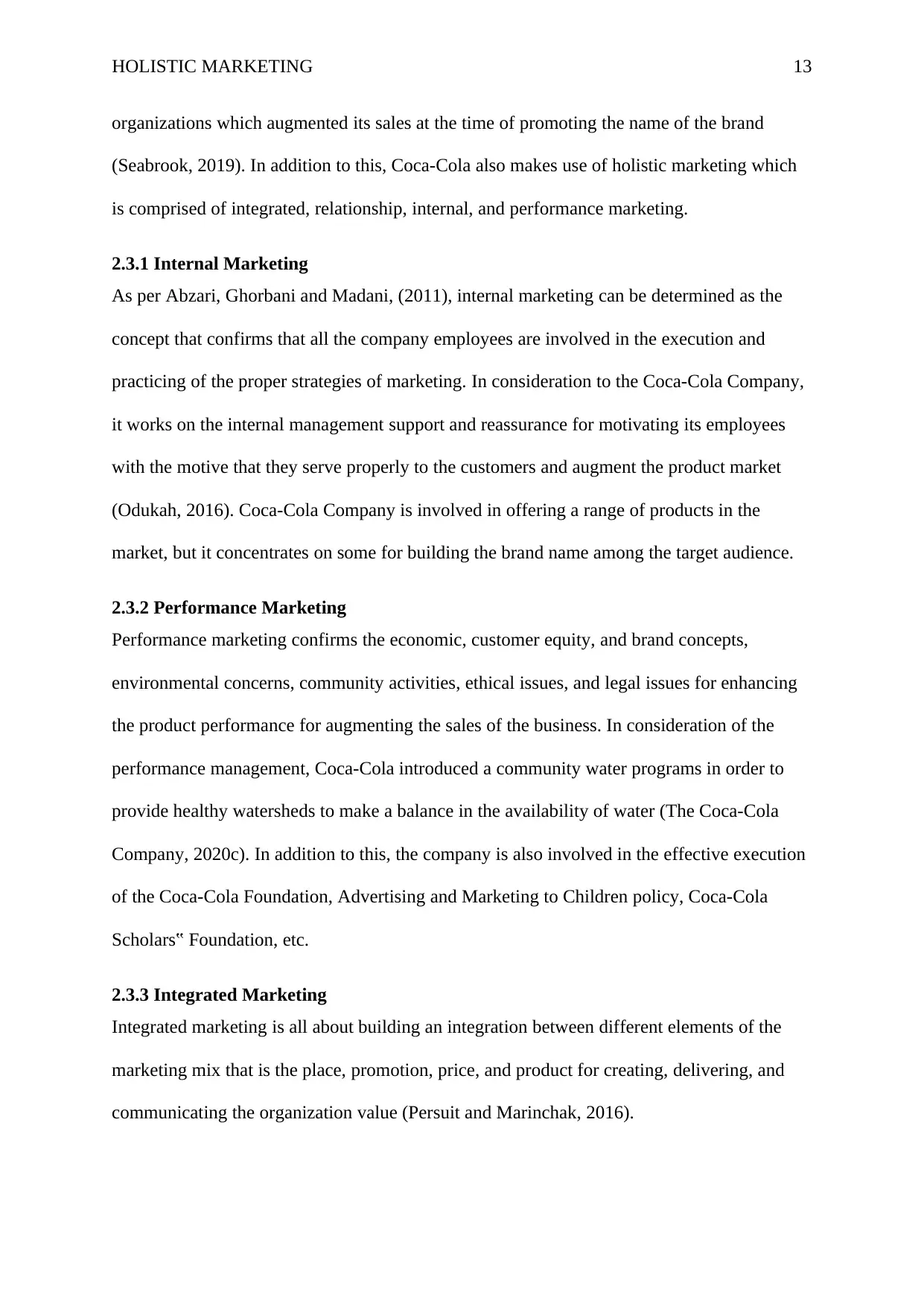
HOLISTIC MARKETING 13
organizations which augmented its sales at the time of promoting the name of the brand
(Seabrook, 2019). In addition to this, Coca-Cola also makes use of holistic marketing which
is comprised of integrated, relationship, internal, and performance marketing.
2.3.1 Internal Marketing
As per Abzari, Ghorbani and Madani, (2011), internal marketing can be determined as the
concept that confirms that all the company employees are involved in the execution and
practicing of the proper strategies of marketing. In consideration to the Coca-Cola Company,
it works on the internal management support and reassurance for motivating its employees
with the motive that they serve properly to the customers and augment the product market
(Odukah, 2016). Coca-Cola Company is involved in offering a range of products in the
market, but it concentrates on some for building the brand name among the target audience.
2.3.2 Performance Marketing
Performance marketing confirms the economic, customer equity, and brand concepts,
environmental concerns, community activities, ethical issues, and legal issues for enhancing
the product performance for augmenting the sales of the business. In consideration of the
performance management, Coca-Cola introduced a community water programs in order to
provide healthy watersheds to make a balance in the availability of water (The Coca-Cola
Company, 2020c). In addition to this, the company is also involved in the effective execution
of the Coca-Cola Foundation, Advertising and Marketing to Children policy, Coca-Cola
Scholars‟ Foundation, etc.
2.3.3 Integrated Marketing
Integrated marketing is all about building an integration between different elements of the
marketing mix that is the place, promotion, price, and product for creating, delivering, and
communicating the organization value (Persuit and Marinchak, 2016).
organizations which augmented its sales at the time of promoting the name of the brand
(Seabrook, 2019). In addition to this, Coca-Cola also makes use of holistic marketing which
is comprised of integrated, relationship, internal, and performance marketing.
2.3.1 Internal Marketing
As per Abzari, Ghorbani and Madani, (2011), internal marketing can be determined as the
concept that confirms that all the company employees are involved in the execution and
practicing of the proper strategies of marketing. In consideration to the Coca-Cola Company,
it works on the internal management support and reassurance for motivating its employees
with the motive that they serve properly to the customers and augment the product market
(Odukah, 2016). Coca-Cola Company is involved in offering a range of products in the
market, but it concentrates on some for building the brand name among the target audience.
2.3.2 Performance Marketing
Performance marketing confirms the economic, customer equity, and brand concepts,
environmental concerns, community activities, ethical issues, and legal issues for enhancing
the product performance for augmenting the sales of the business. In consideration of the
performance management, Coca-Cola introduced a community water programs in order to
provide healthy watersheds to make a balance in the availability of water (The Coca-Cola
Company, 2020c). In addition to this, the company is also involved in the effective execution
of the Coca-Cola Foundation, Advertising and Marketing to Children policy, Coca-Cola
Scholars‟ Foundation, etc.
2.3.3 Integrated Marketing
Integrated marketing is all about building an integration between different elements of the
marketing mix that is the place, promotion, price, and product for creating, delivering, and
communicating the organization value (Persuit and Marinchak, 2016).
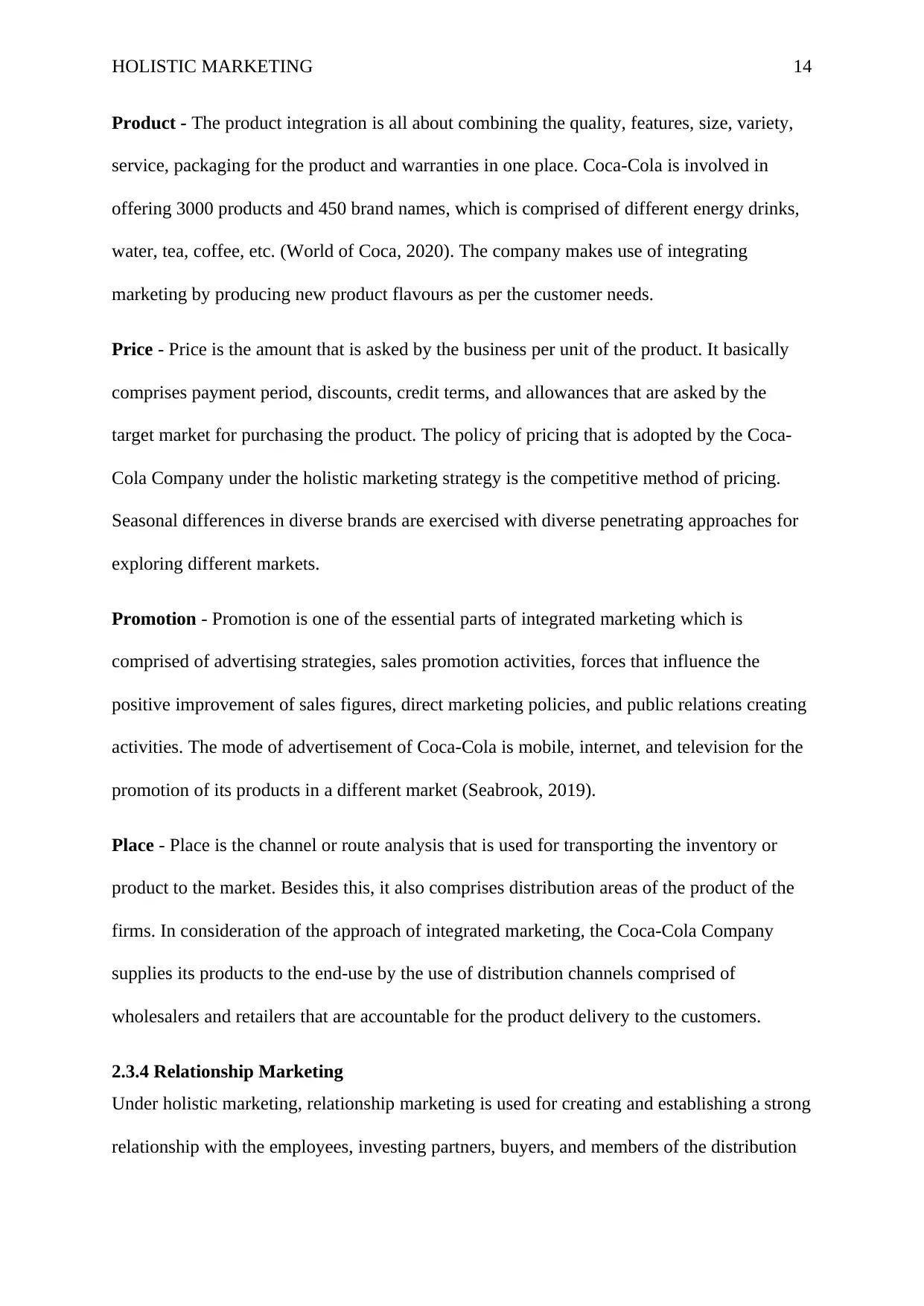
HOLISTIC MARKETING 14
Product - The product integration is all about combining the quality, features, size, variety,
service, packaging for the product and warranties in one place. Coca-Cola is involved in
offering 3000 products and 450 brand names, which is comprised of different energy drinks,
water, tea, coffee, etc. (World of Coca, 2020). The company makes use of integrating
marketing by producing new product flavours as per the customer needs.
Price - Price is the amount that is asked by the business per unit of the product. It basically
comprises payment period, discounts, credit terms, and allowances that are asked by the
target market for purchasing the product. The policy of pricing that is adopted by the Coca-
Cola Company under the holistic marketing strategy is the competitive method of pricing.
Seasonal differences in diverse brands are exercised with diverse penetrating approaches for
exploring different markets.
Promotion - Promotion is one of the essential parts of integrated marketing which is
comprised of advertising strategies, sales promotion activities, forces that influence the
positive improvement of sales figures, direct marketing policies, and public relations creating
activities. The mode of advertisement of Coca-Cola is mobile, internet, and television for the
promotion of its products in a different market (Seabrook, 2019).
Place - Place is the channel or route analysis that is used for transporting the inventory or
product to the market. Besides this, it also comprises distribution areas of the product of the
firms. In consideration of the approach of integrated marketing, the Coca-Cola Company
supplies its products to the end-use by the use of distribution channels comprised of
wholesalers and retailers that are accountable for the product delivery to the customers.
2.3.4 Relationship Marketing
Under holistic marketing, relationship marketing is used for creating and establishing a strong
relationship with the employees, investing partners, buyers, and members of the distribution
Product - The product integration is all about combining the quality, features, size, variety,
service, packaging for the product and warranties in one place. Coca-Cola is involved in
offering 3000 products and 450 brand names, which is comprised of different energy drinks,
water, tea, coffee, etc. (World of Coca, 2020). The company makes use of integrating
marketing by producing new product flavours as per the customer needs.
Price - Price is the amount that is asked by the business per unit of the product. It basically
comprises payment period, discounts, credit terms, and allowances that are asked by the
target market for purchasing the product. The policy of pricing that is adopted by the Coca-
Cola Company under the holistic marketing strategy is the competitive method of pricing.
Seasonal differences in diverse brands are exercised with diverse penetrating approaches for
exploring different markets.
Promotion - Promotion is one of the essential parts of integrated marketing which is
comprised of advertising strategies, sales promotion activities, forces that influence the
positive improvement of sales figures, direct marketing policies, and public relations creating
activities. The mode of advertisement of Coca-Cola is mobile, internet, and television for the
promotion of its products in a different market (Seabrook, 2019).
Place - Place is the channel or route analysis that is used for transporting the inventory or
product to the market. Besides this, it also comprises distribution areas of the product of the
firms. In consideration of the approach of integrated marketing, the Coca-Cola Company
supplies its products to the end-use by the use of distribution channels comprised of
wholesalers and retailers that are accountable for the product delivery to the customers.
2.3.4 Relationship Marketing
Under holistic marketing, relationship marketing is used for creating and establishing a strong
relationship with the employees, investing partners, buyers, and members of the distribution
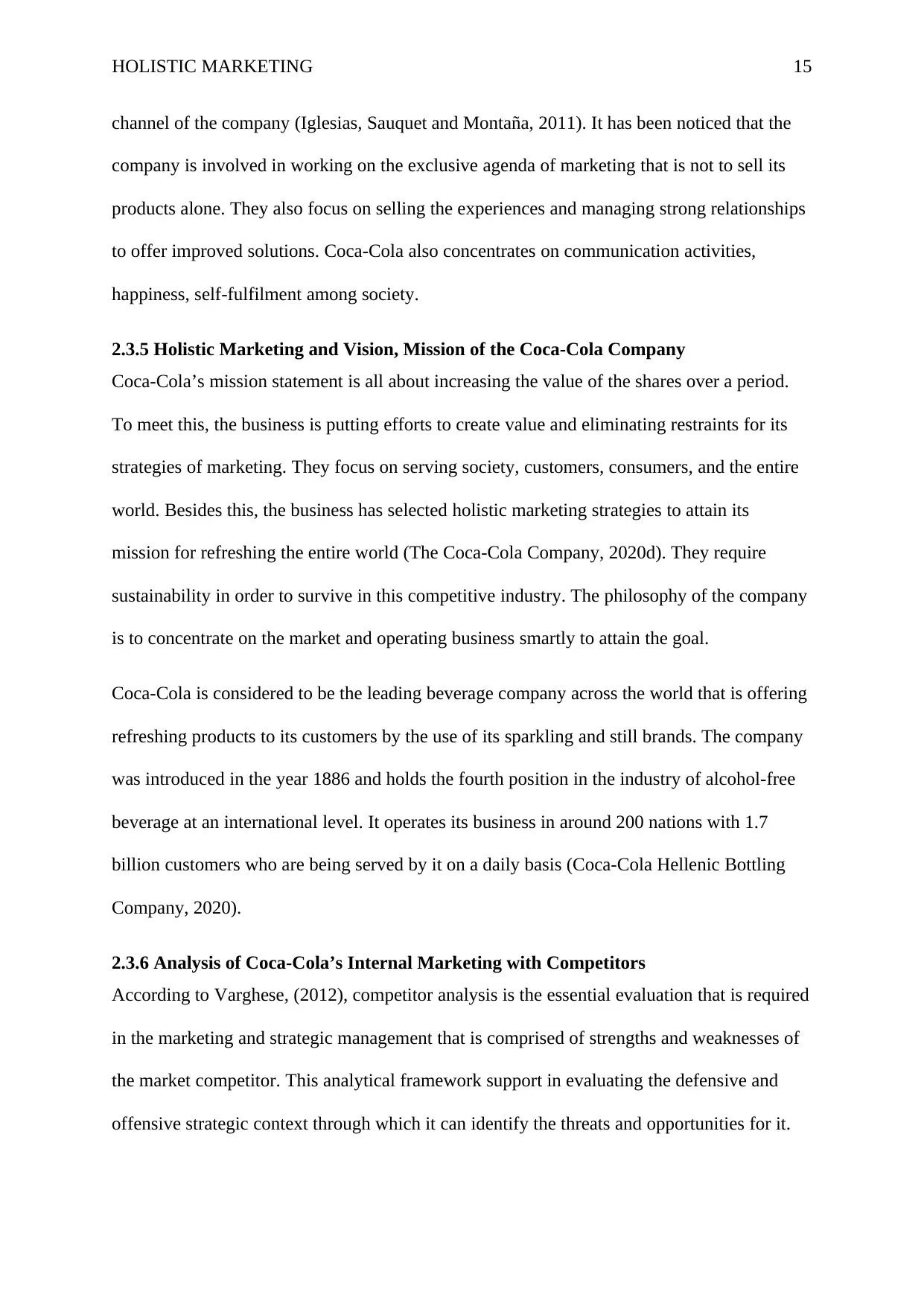
HOLISTIC MARKETING 15
channel of the company (Iglesias, Sauquet and Montaña, 2011). It has been noticed that the
company is involved in working on the exclusive agenda of marketing that is not to sell its
products alone. They also focus on selling the experiences and managing strong relationships
to offer improved solutions. Coca-Cola also concentrates on communication activities,
happiness, self-fulfilment among society.
2.3.5 Holistic Marketing and Vision, Mission of the Coca-Cola Company
Coca-Cola’s mission statement is all about increasing the value of the shares over a period.
To meet this, the business is putting efforts to create value and eliminating restraints for its
strategies of marketing. They focus on serving society, customers, consumers, and the entire
world. Besides this, the business has selected holistic marketing strategies to attain its
mission for refreshing the entire world (The Coca-Cola Company, 2020d). They require
sustainability in order to survive in this competitive industry. The philosophy of the company
is to concentrate on the market and operating business smartly to attain the goal.
Coca-Cola is considered to be the leading beverage company across the world that is offering
refreshing products to its customers by the use of its sparkling and still brands. The company
was introduced in the year 1886 and holds the fourth position in the industry of alcohol-free
beverage at an international level. It operates its business in around 200 nations with 1.7
billion customers who are being served by it on a daily basis (Coca-Cola Hellenic Bottling
Company, 2020).
2.3.6 Analysis of Coca-Cola’s Internal Marketing with Competitors
According to Varghese, (2012), competitor analysis is the essential evaluation that is required
in the marketing and strategic management that is comprised of strengths and weaknesses of
the market competitor. This analytical framework support in evaluating the defensive and
offensive strategic context through which it can identify the threats and opportunities for it.
channel of the company (Iglesias, Sauquet and Montaña, 2011). It has been noticed that the
company is involved in working on the exclusive agenda of marketing that is not to sell its
products alone. They also focus on selling the experiences and managing strong relationships
to offer improved solutions. Coca-Cola also concentrates on communication activities,
happiness, self-fulfilment among society.
2.3.5 Holistic Marketing and Vision, Mission of the Coca-Cola Company
Coca-Cola’s mission statement is all about increasing the value of the shares over a period.
To meet this, the business is putting efforts to create value and eliminating restraints for its
strategies of marketing. They focus on serving society, customers, consumers, and the entire
world. Besides this, the business has selected holistic marketing strategies to attain its
mission for refreshing the entire world (The Coca-Cola Company, 2020d). They require
sustainability in order to survive in this competitive industry. The philosophy of the company
is to concentrate on the market and operating business smartly to attain the goal.
Coca-Cola is considered to be the leading beverage company across the world that is offering
refreshing products to its customers by the use of its sparkling and still brands. The company
was introduced in the year 1886 and holds the fourth position in the industry of alcohol-free
beverage at an international level. It operates its business in around 200 nations with 1.7
billion customers who are being served by it on a daily basis (Coca-Cola Hellenic Bottling
Company, 2020).
2.3.6 Analysis of Coca-Cola’s Internal Marketing with Competitors
According to Varghese, (2012), competitor analysis is the essential evaluation that is required
in the marketing and strategic management that is comprised of strengths and weaknesses of
the market competitor. This analytical framework support in evaluating the defensive and
offensive strategic context through which it can identify the threats and opportunities for it.
Secure Best Marks with AI Grader
Need help grading? Try our AI Grader for instant feedback on your assignments.
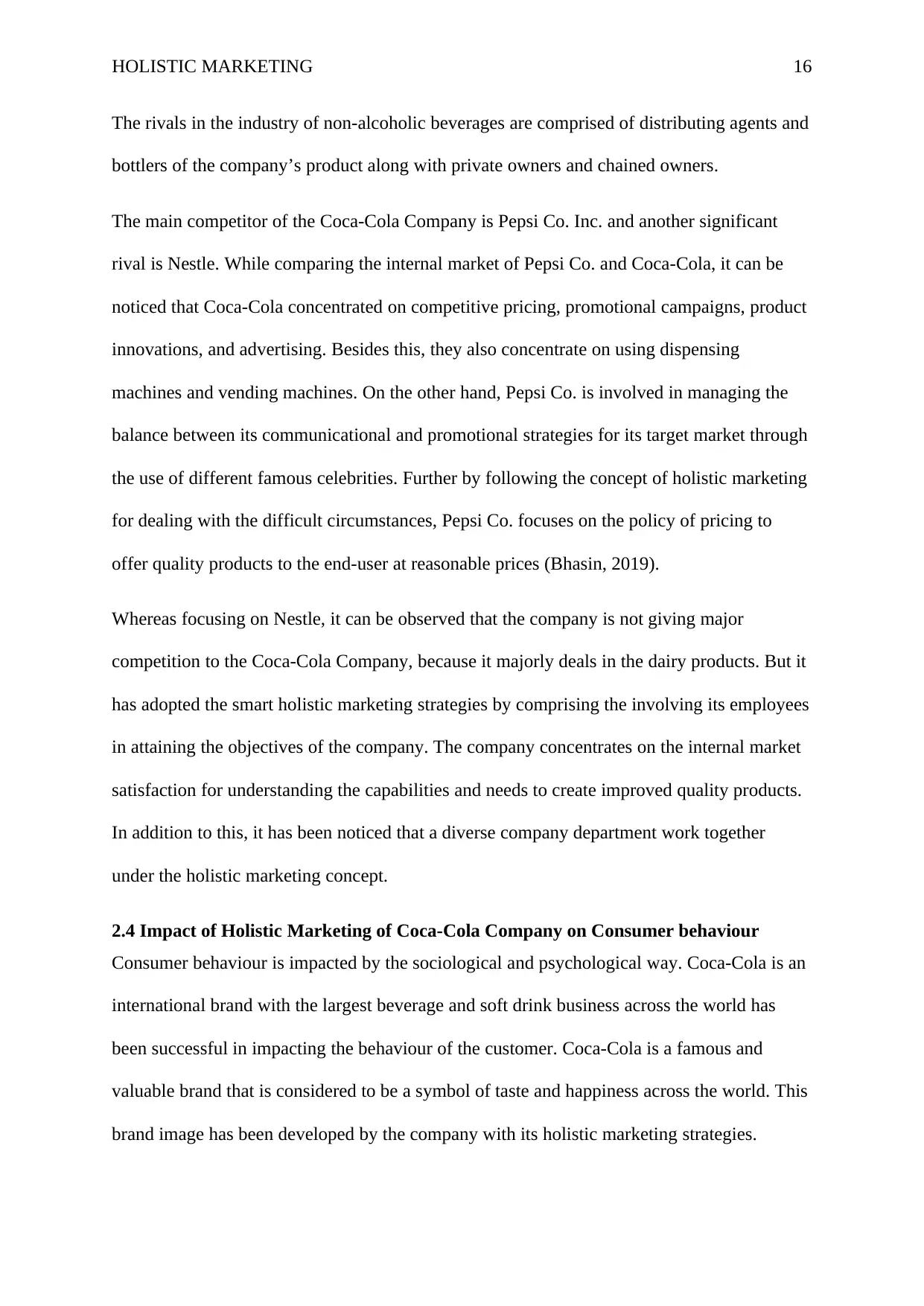
HOLISTIC MARKETING 16
The rivals in the industry of non-alcoholic beverages are comprised of distributing agents and
bottlers of the company’s product along with private owners and chained owners.
The main competitor of the Coca-Cola Company is Pepsi Co. Inc. and another significant
rival is Nestle. While comparing the internal market of Pepsi Co. and Coca-Cola, it can be
noticed that Coca-Cola concentrated on competitive pricing, promotional campaigns, product
innovations, and advertising. Besides this, they also concentrate on using dispensing
machines and vending machines. On the other hand, Pepsi Co. is involved in managing the
balance between its communicational and promotional strategies for its target market through
the use of different famous celebrities. Further by following the concept of holistic marketing
for dealing with the difficult circumstances, Pepsi Co. focuses on the policy of pricing to
offer quality products to the end-user at reasonable prices (Bhasin, 2019).
Whereas focusing on Nestle, it can be observed that the company is not giving major
competition to the Coca-Cola Company, because it majorly deals in the dairy products. But it
has adopted the smart holistic marketing strategies by comprising the involving its employees
in attaining the objectives of the company. The company concentrates on the internal market
satisfaction for understanding the capabilities and needs to create improved quality products.
In addition to this, it has been noticed that a diverse company department work together
under the holistic marketing concept.
2.4 Impact of Holistic Marketing of Coca-Cola Company on Consumer behaviour
Consumer behaviour is impacted by the sociological and psychological way. Coca-Cola is an
international brand with the largest beverage and soft drink business across the world has
been successful in impacting the behaviour of the customer. Coca-Cola is a famous and
valuable brand that is considered to be a symbol of taste and happiness across the world. This
brand image has been developed by the company with its holistic marketing strategies.
The rivals in the industry of non-alcoholic beverages are comprised of distributing agents and
bottlers of the company’s product along with private owners and chained owners.
The main competitor of the Coca-Cola Company is Pepsi Co. Inc. and another significant
rival is Nestle. While comparing the internal market of Pepsi Co. and Coca-Cola, it can be
noticed that Coca-Cola concentrated on competitive pricing, promotional campaigns, product
innovations, and advertising. Besides this, they also concentrate on using dispensing
machines and vending machines. On the other hand, Pepsi Co. is involved in managing the
balance between its communicational and promotional strategies for its target market through
the use of different famous celebrities. Further by following the concept of holistic marketing
for dealing with the difficult circumstances, Pepsi Co. focuses on the policy of pricing to
offer quality products to the end-user at reasonable prices (Bhasin, 2019).
Whereas focusing on Nestle, it can be observed that the company is not giving major
competition to the Coca-Cola Company, because it majorly deals in the dairy products. But it
has adopted the smart holistic marketing strategies by comprising the involving its employees
in attaining the objectives of the company. The company concentrates on the internal market
satisfaction for understanding the capabilities and needs to create improved quality products.
In addition to this, it has been noticed that a diverse company department work together
under the holistic marketing concept.
2.4 Impact of Holistic Marketing of Coca-Cola Company on Consumer behaviour
Consumer behaviour is impacted by the sociological and psychological way. Coca-Cola is an
international brand with the largest beverage and soft drink business across the world has
been successful in impacting the behaviour of the customer. Coca-Cola is a famous and
valuable brand that is considered to be a symbol of taste and happiness across the world. This
brand image has been developed by the company with its holistic marketing strategies.
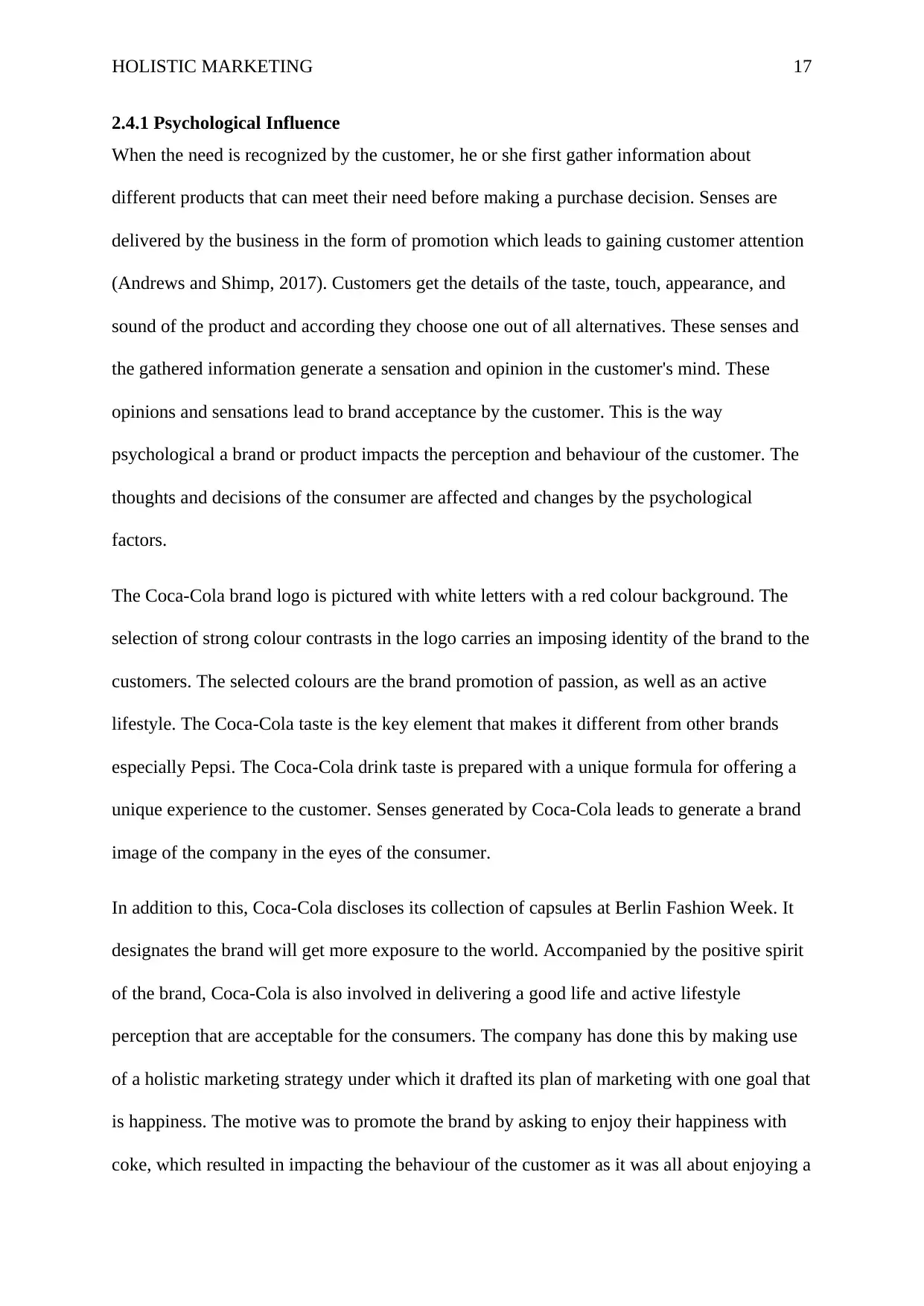
HOLISTIC MARKETING 17
2.4.1 Psychological Influence
When the need is recognized by the customer, he or she first gather information about
different products that can meet their need before making a purchase decision. Senses are
delivered by the business in the form of promotion which leads to gaining customer attention
(Andrews and Shimp, 2017). Customers get the details of the taste, touch, appearance, and
sound of the product and according they choose one out of all alternatives. These senses and
the gathered information generate a sensation and opinion in the customer's mind. These
opinions and sensations lead to brand acceptance by the customer. This is the way
psychological a brand or product impacts the perception and behaviour of the customer. The
thoughts and decisions of the consumer are affected and changes by the psychological
factors.
The Coca-Cola brand logo is pictured with white letters with a red colour background. The
selection of strong colour contrasts in the logo carries an imposing identity of the brand to the
customers. The selected colours are the brand promotion of passion, as well as an active
lifestyle. The Coca-Cola taste is the key element that makes it different from other brands
especially Pepsi. The Coca-Cola drink taste is prepared with a unique formula for offering a
unique experience to the customer. Senses generated by Coca-Cola leads to generate a brand
image of the company in the eyes of the consumer.
In addition to this, Coca-Cola discloses its collection of capsules at Berlin Fashion Week. It
designates the brand will get more exposure to the world. Accompanied by the positive spirit
of the brand, Coca-Cola is also involved in delivering a good life and active lifestyle
perception that are acceptable for the consumers. The company has done this by making use
of a holistic marketing strategy under which it drafted its plan of marketing with one goal that
is happiness. The motive was to promote the brand by asking to enjoy their happiness with
coke, which resulted in impacting the behaviour of the customer as it was all about enjoying a
2.4.1 Psychological Influence
When the need is recognized by the customer, he or she first gather information about
different products that can meet their need before making a purchase decision. Senses are
delivered by the business in the form of promotion which leads to gaining customer attention
(Andrews and Shimp, 2017). Customers get the details of the taste, touch, appearance, and
sound of the product and according they choose one out of all alternatives. These senses and
the gathered information generate a sensation and opinion in the customer's mind. These
opinions and sensations lead to brand acceptance by the customer. This is the way
psychological a brand or product impacts the perception and behaviour of the customer. The
thoughts and decisions of the consumer are affected and changes by the psychological
factors.
The Coca-Cola brand logo is pictured with white letters with a red colour background. The
selection of strong colour contrasts in the logo carries an imposing identity of the brand to the
customers. The selected colours are the brand promotion of passion, as well as an active
lifestyle. The Coca-Cola taste is the key element that makes it different from other brands
especially Pepsi. The Coca-Cola drink taste is prepared with a unique formula for offering a
unique experience to the customer. Senses generated by Coca-Cola leads to generate a brand
image of the company in the eyes of the consumer.
In addition to this, Coca-Cola discloses its collection of capsules at Berlin Fashion Week. It
designates the brand will get more exposure to the world. Accompanied by the positive spirit
of the brand, Coca-Cola is also involved in delivering a good life and active lifestyle
perception that are acceptable for the consumers. The company has done this by making use
of a holistic marketing strategy under which it drafted its plan of marketing with one goal that
is happiness. The motive was to promote the brand by asking to enjoy their happiness with
coke, which resulted in impacting the behaviour of the customer as it was all about enjoying a
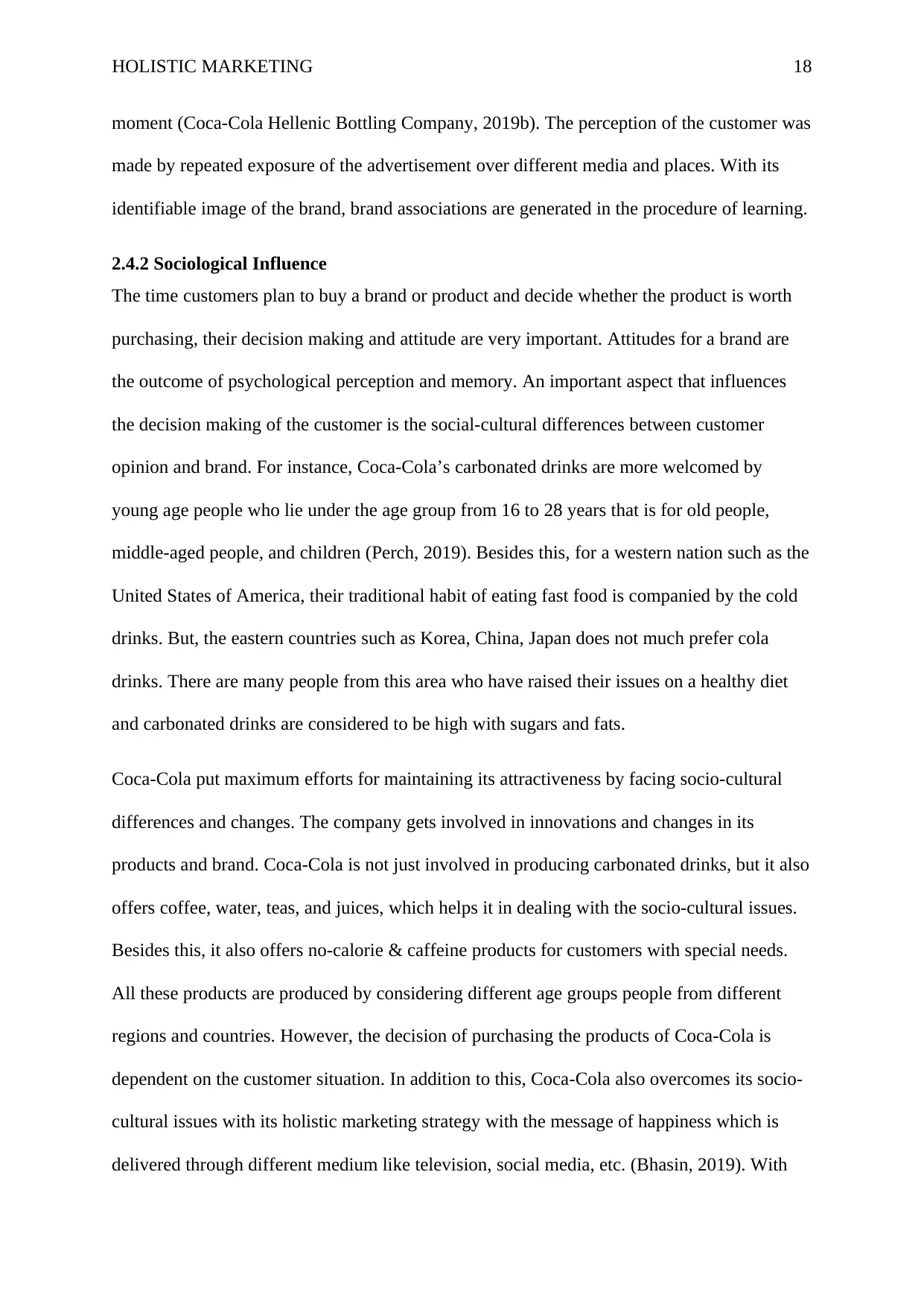
HOLISTIC MARKETING 18
moment (Coca-Cola Hellenic Bottling Company, 2019b). The perception of the customer was
made by repeated exposure of the advertisement over different media and places. With its
identifiable image of the brand, brand associations are generated in the procedure of learning.
2.4.2 Sociological Influence
The time customers plan to buy a brand or product and decide whether the product is worth
purchasing, their decision making and attitude are very important. Attitudes for a brand are
the outcome of psychological perception and memory. An important aspect that influences
the decision making of the customer is the social-cultural differences between customer
opinion and brand. For instance, Coca-Cola’s carbonated drinks are more welcomed by
young age people who lie under the age group from 16 to 28 years that is for old people,
middle-aged people, and children (Perch, 2019). Besides this, for a western nation such as the
United States of America, their traditional habit of eating fast food is companied by the cold
drinks. But, the eastern countries such as Korea, China, Japan does not much prefer cola
drinks. There are many people from this area who have raised their issues on a healthy diet
and carbonated drinks are considered to be high with sugars and fats.
Coca-Cola put maximum efforts for maintaining its attractiveness by facing socio-cultural
differences and changes. The company gets involved in innovations and changes in its
products and brand. Coca-Cola is not just involved in producing carbonated drinks, but it also
offers coffee, water, teas, and juices, which helps it in dealing with the socio-cultural issues.
Besides this, it also offers no-calorie & caffeine products for customers with special needs.
All these products are produced by considering different age groups people from different
regions and countries. However, the decision of purchasing the products of Coca-Cola is
dependent on the customer situation. In addition to this, Coca-Cola also overcomes its socio-
cultural issues with its holistic marketing strategy with the message of happiness which is
delivered through different medium like television, social media, etc. (Bhasin, 2019). With
moment (Coca-Cola Hellenic Bottling Company, 2019b). The perception of the customer was
made by repeated exposure of the advertisement over different media and places. With its
identifiable image of the brand, brand associations are generated in the procedure of learning.
2.4.2 Sociological Influence
The time customers plan to buy a brand or product and decide whether the product is worth
purchasing, their decision making and attitude are very important. Attitudes for a brand are
the outcome of psychological perception and memory. An important aspect that influences
the decision making of the customer is the social-cultural differences between customer
opinion and brand. For instance, Coca-Cola’s carbonated drinks are more welcomed by
young age people who lie under the age group from 16 to 28 years that is for old people,
middle-aged people, and children (Perch, 2019). Besides this, for a western nation such as the
United States of America, their traditional habit of eating fast food is companied by the cold
drinks. But, the eastern countries such as Korea, China, Japan does not much prefer cola
drinks. There are many people from this area who have raised their issues on a healthy diet
and carbonated drinks are considered to be high with sugars and fats.
Coca-Cola put maximum efforts for maintaining its attractiveness by facing socio-cultural
differences and changes. The company gets involved in innovations and changes in its
products and brand. Coca-Cola is not just involved in producing carbonated drinks, but it also
offers coffee, water, teas, and juices, which helps it in dealing with the socio-cultural issues.
Besides this, it also offers no-calorie & caffeine products for customers with special needs.
All these products are produced by considering different age groups people from different
regions and countries. However, the decision of purchasing the products of Coca-Cola is
dependent on the customer situation. In addition to this, Coca-Cola also overcomes its socio-
cultural issues with its holistic marketing strategy with the message of happiness which is
delivered through different medium like television, social media, etc. (Bhasin, 2019). With
Paraphrase This Document
Need a fresh take? Get an instant paraphrase of this document with our AI Paraphraser
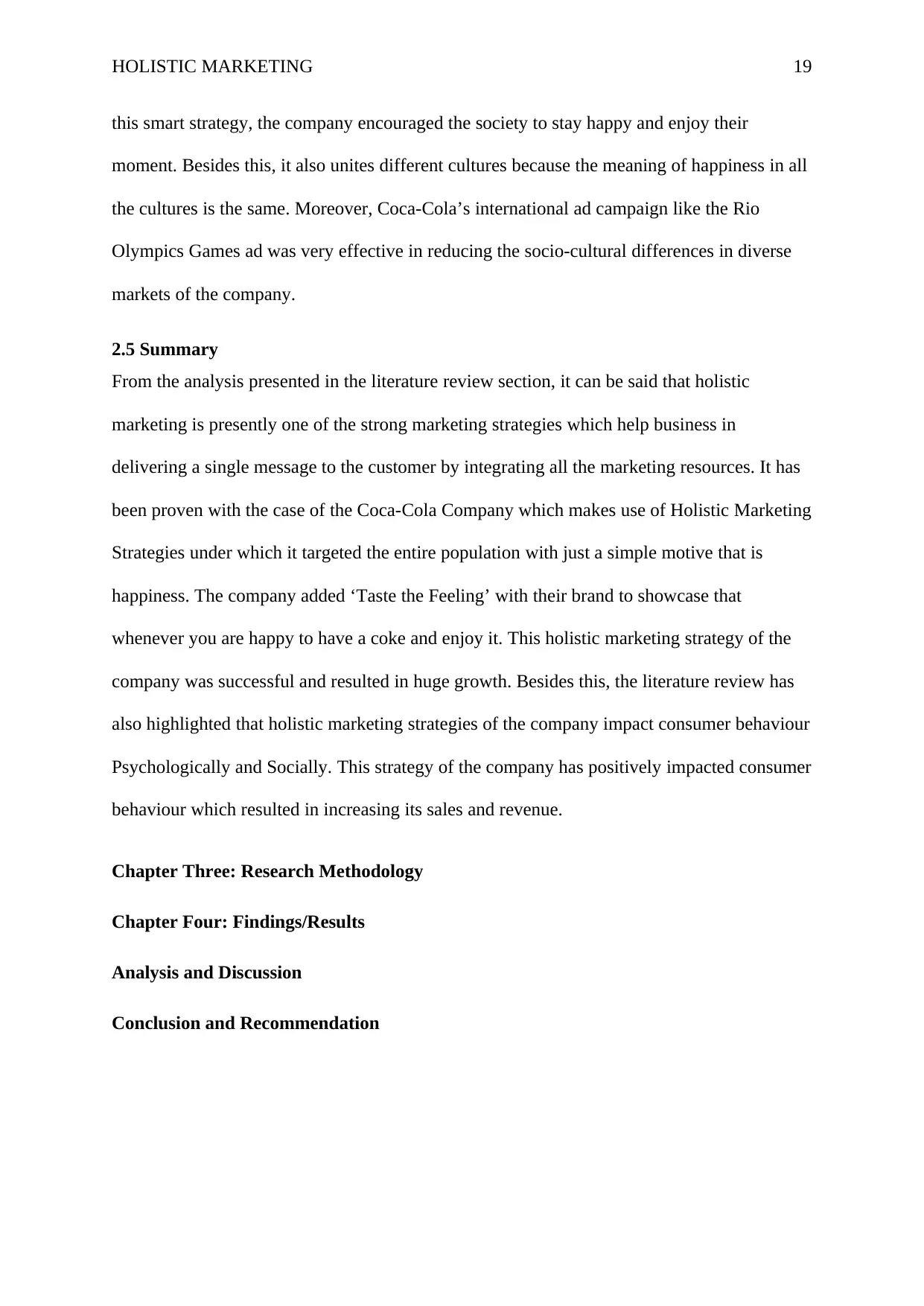
HOLISTIC MARKETING 19
this smart strategy, the company encouraged the society to stay happy and enjoy their
moment. Besides this, it also unites different cultures because the meaning of happiness in all
the cultures is the same. Moreover, Coca-Cola’s international ad campaign like the Rio
Olympics Games ad was very effective in reducing the socio-cultural differences in diverse
markets of the company.
2.5 Summary
From the analysis presented in the literature review section, it can be said that holistic
marketing is presently one of the strong marketing strategies which help business in
delivering a single message to the customer by integrating all the marketing resources. It has
been proven with the case of the Coca-Cola Company which makes use of Holistic Marketing
Strategies under which it targeted the entire population with just a simple motive that is
happiness. The company added ‘Taste the Feeling’ with their brand to showcase that
whenever you are happy to have a coke and enjoy it. This holistic marketing strategy of the
company was successful and resulted in huge growth. Besides this, the literature review has
also highlighted that holistic marketing strategies of the company impact consumer behaviour
Psychologically and Socially. This strategy of the company has positively impacted consumer
behaviour which resulted in increasing its sales and revenue.
Chapter Three: Research Methodology
Chapter Four: Findings/Results
Analysis and Discussion
Conclusion and Recommendation
this smart strategy, the company encouraged the society to stay happy and enjoy their
moment. Besides this, it also unites different cultures because the meaning of happiness in all
the cultures is the same. Moreover, Coca-Cola’s international ad campaign like the Rio
Olympics Games ad was very effective in reducing the socio-cultural differences in diverse
markets of the company.
2.5 Summary
From the analysis presented in the literature review section, it can be said that holistic
marketing is presently one of the strong marketing strategies which help business in
delivering a single message to the customer by integrating all the marketing resources. It has
been proven with the case of the Coca-Cola Company which makes use of Holistic Marketing
Strategies under which it targeted the entire population with just a simple motive that is
happiness. The company added ‘Taste the Feeling’ with their brand to showcase that
whenever you are happy to have a coke and enjoy it. This holistic marketing strategy of the
company was successful and resulted in huge growth. Besides this, the literature review has
also highlighted that holistic marketing strategies of the company impact consumer behaviour
Psychologically and Socially. This strategy of the company has positively impacted consumer
behaviour which resulted in increasing its sales and revenue.
Chapter Three: Research Methodology
Chapter Four: Findings/Results
Analysis and Discussion
Conclusion and Recommendation
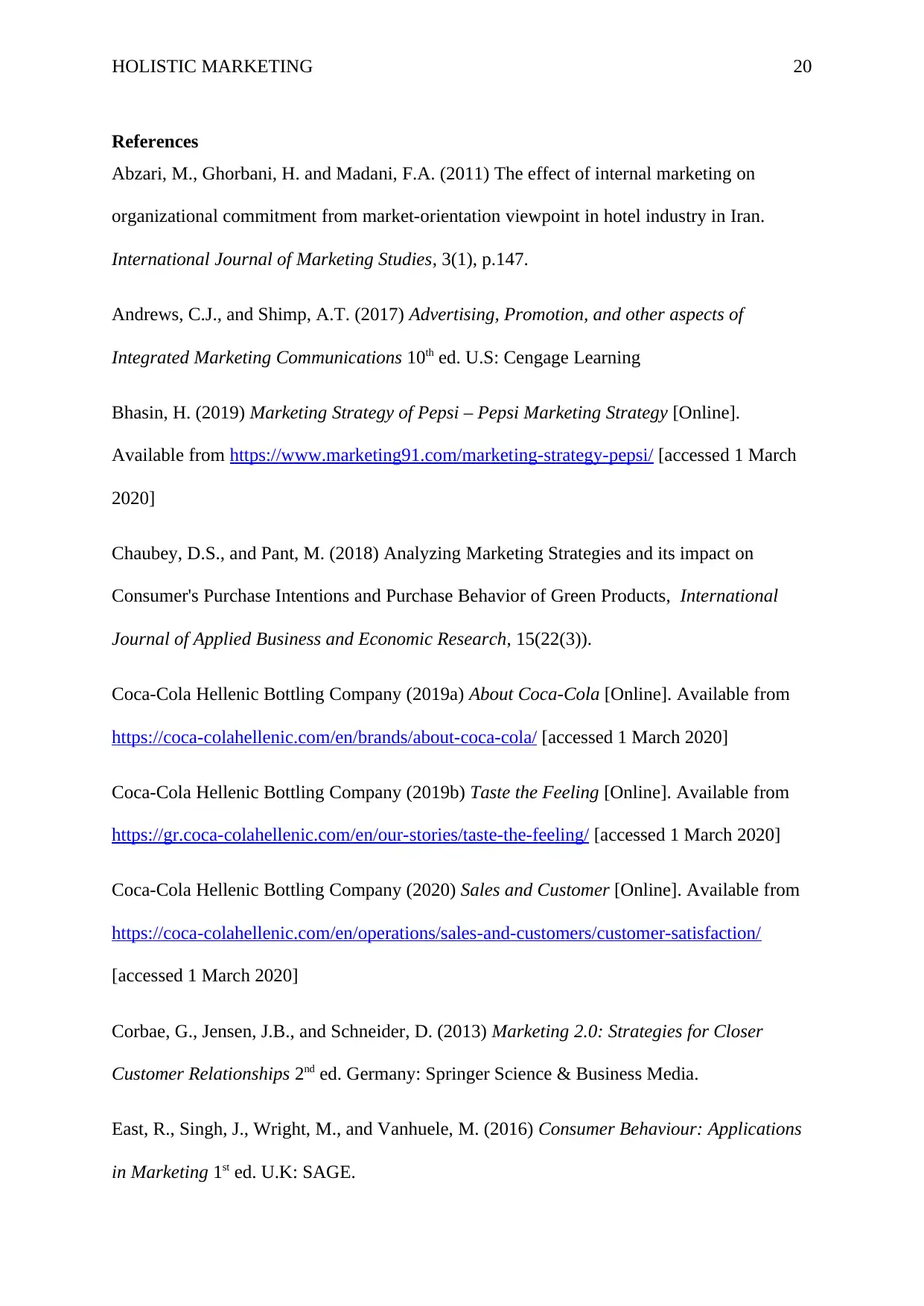
HOLISTIC MARKETING 20
References
Abzari, M., Ghorbani, H. and Madani, F.A. (2011) The effect of internal marketing on
organizational commitment from market-orientation viewpoint in hotel industry in Iran.
International Journal of Marketing Studies, 3(1), p.147.
Andrews, C.J., and Shimp, A.T. (2017) Advertising, Promotion, and other aspects of
Integrated Marketing Communications 10th ed. U.S: Cengage Learning
Bhasin, H. (2019) Marketing Strategy of Pepsi – Pepsi Marketing Strategy [Online].
Available from https://www.marketing91.com/marketing-strategy-pepsi/ [accessed 1 March
2020]
Chaubey, D.S., and Pant, M. (2018) Analyzing Marketing Strategies and its impact on
Consumer's Purchase Intentions and Purchase Behavior of Green Products, International
Journal of Applied Business and Economic Research, 15(22(3)).
Coca-Cola Hellenic Bottling Company (2019a) About Coca-Cola [Online]. Available from
https://coca-colahellenic.com/en/brands/about-coca-cola/ [accessed 1 March 2020]
Coca-Cola Hellenic Bottling Company (2019b) Taste the Feeling [Online]. Available from
https://gr.coca-colahellenic.com/en/our-stories/taste-the-feeling/ [accessed 1 March 2020]
Coca-Cola Hellenic Bottling Company (2020) Sales and Customer [Online]. Available from
https://coca-colahellenic.com/en/operations/sales-and-customers/customer-satisfaction/
[accessed 1 March 2020]
Corbae, G., Jensen, J.B., and Schneider, D. (2013) Marketing 2.0: Strategies for Closer
Customer Relationships 2nd ed. Germany: Springer Science & Business Media.
East, R., Singh, J., Wright, M., and Vanhuele, M. (2016) Consumer Behaviour: Applications
in Marketing 1st ed. U.K: SAGE.
References
Abzari, M., Ghorbani, H. and Madani, F.A. (2011) The effect of internal marketing on
organizational commitment from market-orientation viewpoint in hotel industry in Iran.
International Journal of Marketing Studies, 3(1), p.147.
Andrews, C.J., and Shimp, A.T. (2017) Advertising, Promotion, and other aspects of
Integrated Marketing Communications 10th ed. U.S: Cengage Learning
Bhasin, H. (2019) Marketing Strategy of Pepsi – Pepsi Marketing Strategy [Online].
Available from https://www.marketing91.com/marketing-strategy-pepsi/ [accessed 1 March
2020]
Chaubey, D.S., and Pant, M. (2018) Analyzing Marketing Strategies and its impact on
Consumer's Purchase Intentions and Purchase Behavior of Green Products, International
Journal of Applied Business and Economic Research, 15(22(3)).
Coca-Cola Hellenic Bottling Company (2019a) About Coca-Cola [Online]. Available from
https://coca-colahellenic.com/en/brands/about-coca-cola/ [accessed 1 March 2020]
Coca-Cola Hellenic Bottling Company (2019b) Taste the Feeling [Online]. Available from
https://gr.coca-colahellenic.com/en/our-stories/taste-the-feeling/ [accessed 1 March 2020]
Coca-Cola Hellenic Bottling Company (2020) Sales and Customer [Online]. Available from
https://coca-colahellenic.com/en/operations/sales-and-customers/customer-satisfaction/
[accessed 1 March 2020]
Corbae, G., Jensen, J.B., and Schneider, D. (2013) Marketing 2.0: Strategies for Closer
Customer Relationships 2nd ed. Germany: Springer Science & Business Media.
East, R., Singh, J., Wright, M., and Vanhuele, M. (2016) Consumer Behaviour: Applications
in Marketing 1st ed. U.K: SAGE.
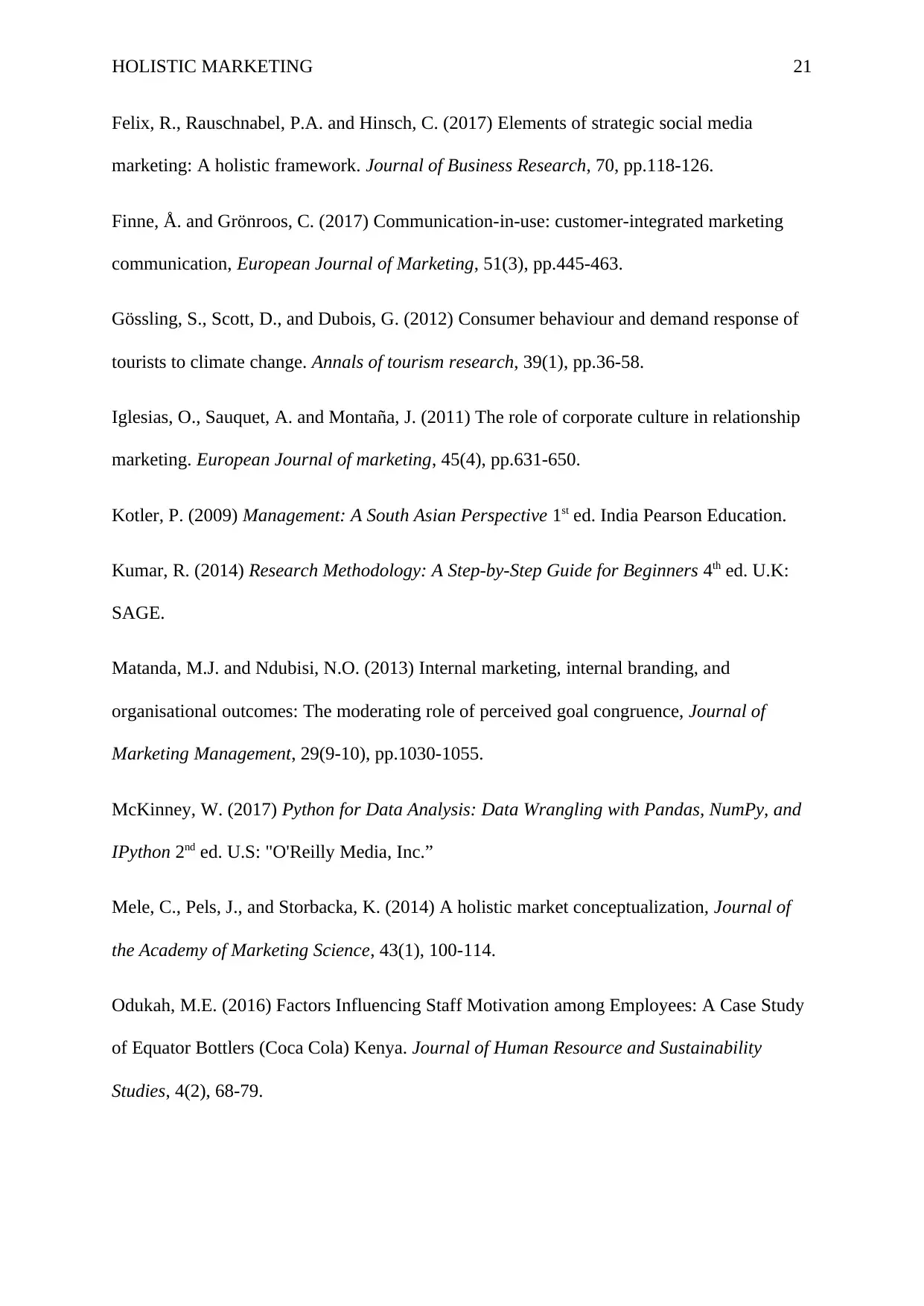
HOLISTIC MARKETING 21
Felix, R., Rauschnabel, P.A. and Hinsch, C. (2017) Elements of strategic social media
marketing: A holistic framework. Journal of Business Research, 70, pp.118-126.
Finne, Å. and Grönroos, C. (2017) Communication-in-use: customer-integrated marketing
communication, European Journal of Marketing, 51(3), pp.445-463.
Gössling, S., Scott, D., and Dubois, G. (2012) Consumer behaviour and demand response of
tourists to climate change. Annals of tourism research, 39(1), pp.36-58.
Iglesias, O., Sauquet, A. and Montaña, J. (2011) The role of corporate culture in relationship
marketing. European Journal of marketing, 45(4), pp.631-650.
Kotler, P. (2009) Management: A South Asian Perspective 1st ed. India Pearson Education.
Kumar, R. (2014) Research Methodology: A Step-by-Step Guide for Beginners 4th ed. U.K:
SAGE.
Matanda, M.J. and Ndubisi, N.O. (2013) Internal marketing, internal branding, and
organisational outcomes: The moderating role of perceived goal congruence, Journal of
Marketing Management, 29(9-10), pp.1030-1055.
McKinney, W. (2017) Python for Data Analysis: Data Wrangling with Pandas, NumPy, and
IPython 2nd ed. U.S: "O'Reilly Media, Inc.”
Mele, C., Pels, J., and Storbacka, K. (2014) A holistic market conceptualization, Journal of
the Academy of Marketing Science, 43(1), 100-114.
Odukah, M.E. (2016) Factors Influencing Staff Motivation among Employees: A Case Study
of Equator Bottlers (Coca Cola) Kenya. Journal of Human Resource and Sustainability
Studies, 4(2), 68-79.
Felix, R., Rauschnabel, P.A. and Hinsch, C. (2017) Elements of strategic social media
marketing: A holistic framework. Journal of Business Research, 70, pp.118-126.
Finne, Å. and Grönroos, C. (2017) Communication-in-use: customer-integrated marketing
communication, European Journal of Marketing, 51(3), pp.445-463.
Gössling, S., Scott, D., and Dubois, G. (2012) Consumer behaviour and demand response of
tourists to climate change. Annals of tourism research, 39(1), pp.36-58.
Iglesias, O., Sauquet, A. and Montaña, J. (2011) The role of corporate culture in relationship
marketing. European Journal of marketing, 45(4), pp.631-650.
Kotler, P. (2009) Management: A South Asian Perspective 1st ed. India Pearson Education.
Kumar, R. (2014) Research Methodology: A Step-by-Step Guide for Beginners 4th ed. U.K:
SAGE.
Matanda, M.J. and Ndubisi, N.O. (2013) Internal marketing, internal branding, and
organisational outcomes: The moderating role of perceived goal congruence, Journal of
Marketing Management, 29(9-10), pp.1030-1055.
McKinney, W. (2017) Python for Data Analysis: Data Wrangling with Pandas, NumPy, and
IPython 2nd ed. U.S: "O'Reilly Media, Inc.”
Mele, C., Pels, J., and Storbacka, K. (2014) A holistic market conceptualization, Journal of
the Academy of Marketing Science, 43(1), 100-114.
Odukah, M.E. (2016) Factors Influencing Staff Motivation among Employees: A Case Study
of Equator Bottlers (Coca Cola) Kenya. Journal of Human Resource and Sustainability
Studies, 4(2), 68-79.
Secure Best Marks with AI Grader
Need help grading? Try our AI Grader for instant feedback on your assignments.
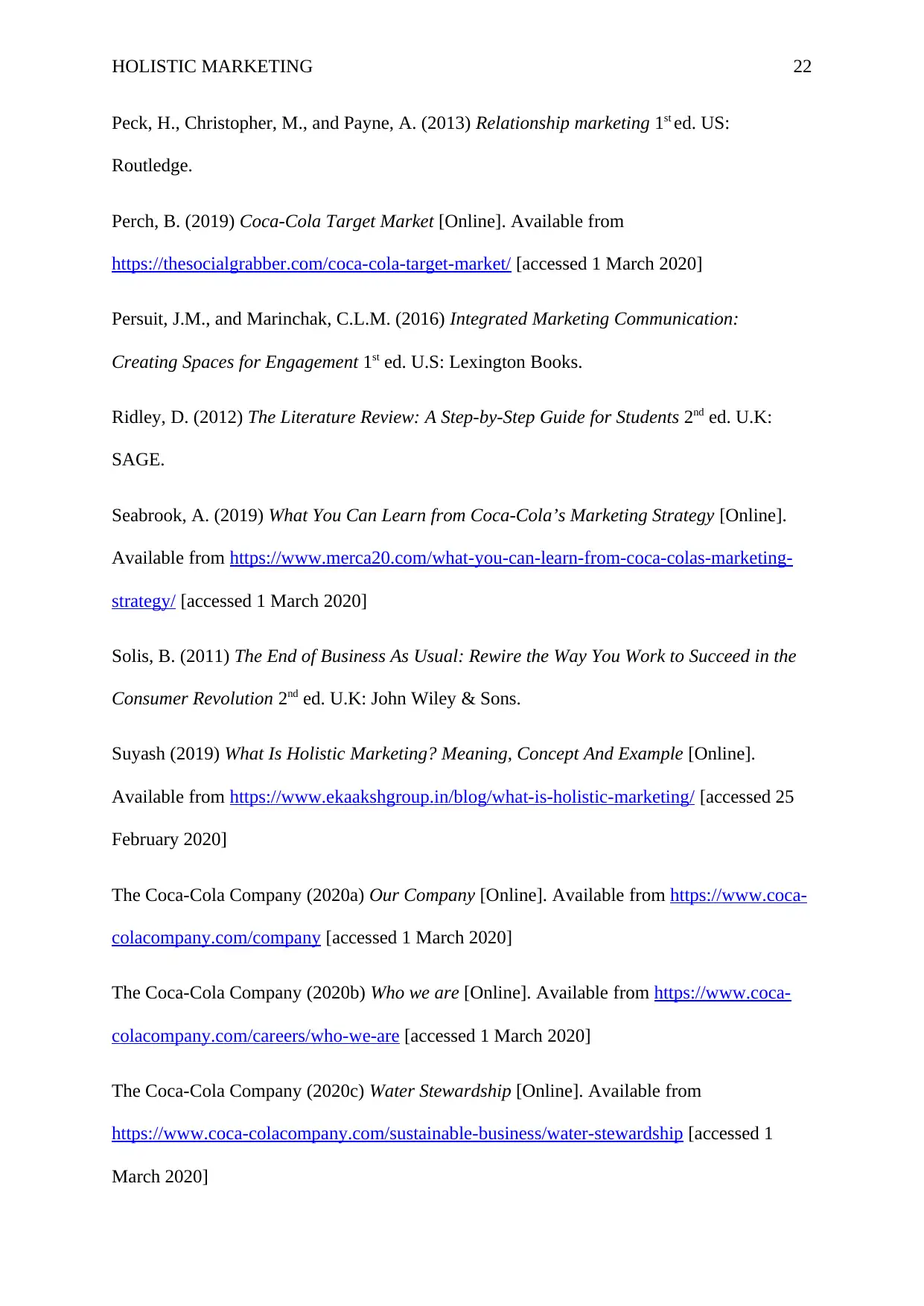
HOLISTIC MARKETING 22
Peck, H., Christopher, M., and Payne, A. (2013) Relationship marketing 1st ed. US:
Routledge.
Perch, B. (2019) Coca-Cola Target Market [Online]. Available from
https://thesocialgrabber.com/coca-cola-target-market/ [accessed 1 March 2020]
Persuit, J.M., and Marinchak, C.L.M. (2016) Integrated Marketing Communication:
Creating Spaces for Engagement 1st ed. U.S: Lexington Books.
Ridley, D. (2012) The Literature Review: A Step-by-Step Guide for Students 2nd ed. U.K:
SAGE.
Seabrook, A. (2019) What You Can Learn from Coca-Cola’s Marketing Strategy [Online].
Available from https://www.merca20.com/what-you-can-learn-from-coca-colas-marketing-
strategy/ [accessed 1 March 2020]
Solis, B. (2011) The End of Business As Usual: Rewire the Way You Work to Succeed in the
Consumer Revolution 2nd ed. U.K: John Wiley & Sons.
Suyash (2019) What Is Holistic Marketing? Meaning, Concept And Example [Online].
Available from https://www.ekaakshgroup.in/blog/what-is-holistic-marketing/ [accessed 25
February 2020]
The Coca-Cola Company (2020a) Our Company [Online]. Available from https://www.coca-
colacompany.com/company [accessed 1 March 2020]
The Coca-Cola Company (2020b) Who we are [Online]. Available from https://www.coca-
colacompany.com/careers/who-we-are [accessed 1 March 2020]
The Coca-Cola Company (2020c) Water Stewardship [Online]. Available from
https://www.coca-colacompany.com/sustainable-business/water-stewardship [accessed 1
March 2020]
Peck, H., Christopher, M., and Payne, A. (2013) Relationship marketing 1st ed. US:
Routledge.
Perch, B. (2019) Coca-Cola Target Market [Online]. Available from
https://thesocialgrabber.com/coca-cola-target-market/ [accessed 1 March 2020]
Persuit, J.M., and Marinchak, C.L.M. (2016) Integrated Marketing Communication:
Creating Spaces for Engagement 1st ed. U.S: Lexington Books.
Ridley, D. (2012) The Literature Review: A Step-by-Step Guide for Students 2nd ed. U.K:
SAGE.
Seabrook, A. (2019) What You Can Learn from Coca-Cola’s Marketing Strategy [Online].
Available from https://www.merca20.com/what-you-can-learn-from-coca-colas-marketing-
strategy/ [accessed 1 March 2020]
Solis, B. (2011) The End of Business As Usual: Rewire the Way You Work to Succeed in the
Consumer Revolution 2nd ed. U.K: John Wiley & Sons.
Suyash (2019) What Is Holistic Marketing? Meaning, Concept And Example [Online].
Available from https://www.ekaakshgroup.in/blog/what-is-holistic-marketing/ [accessed 25
February 2020]
The Coca-Cola Company (2020a) Our Company [Online]. Available from https://www.coca-
colacompany.com/company [accessed 1 March 2020]
The Coca-Cola Company (2020b) Who we are [Online]. Available from https://www.coca-
colacompany.com/careers/who-we-are [accessed 1 March 2020]
The Coca-Cola Company (2020c) Water Stewardship [Online]. Available from
https://www.coca-colacompany.com/sustainable-business/water-stewardship [accessed 1
March 2020]
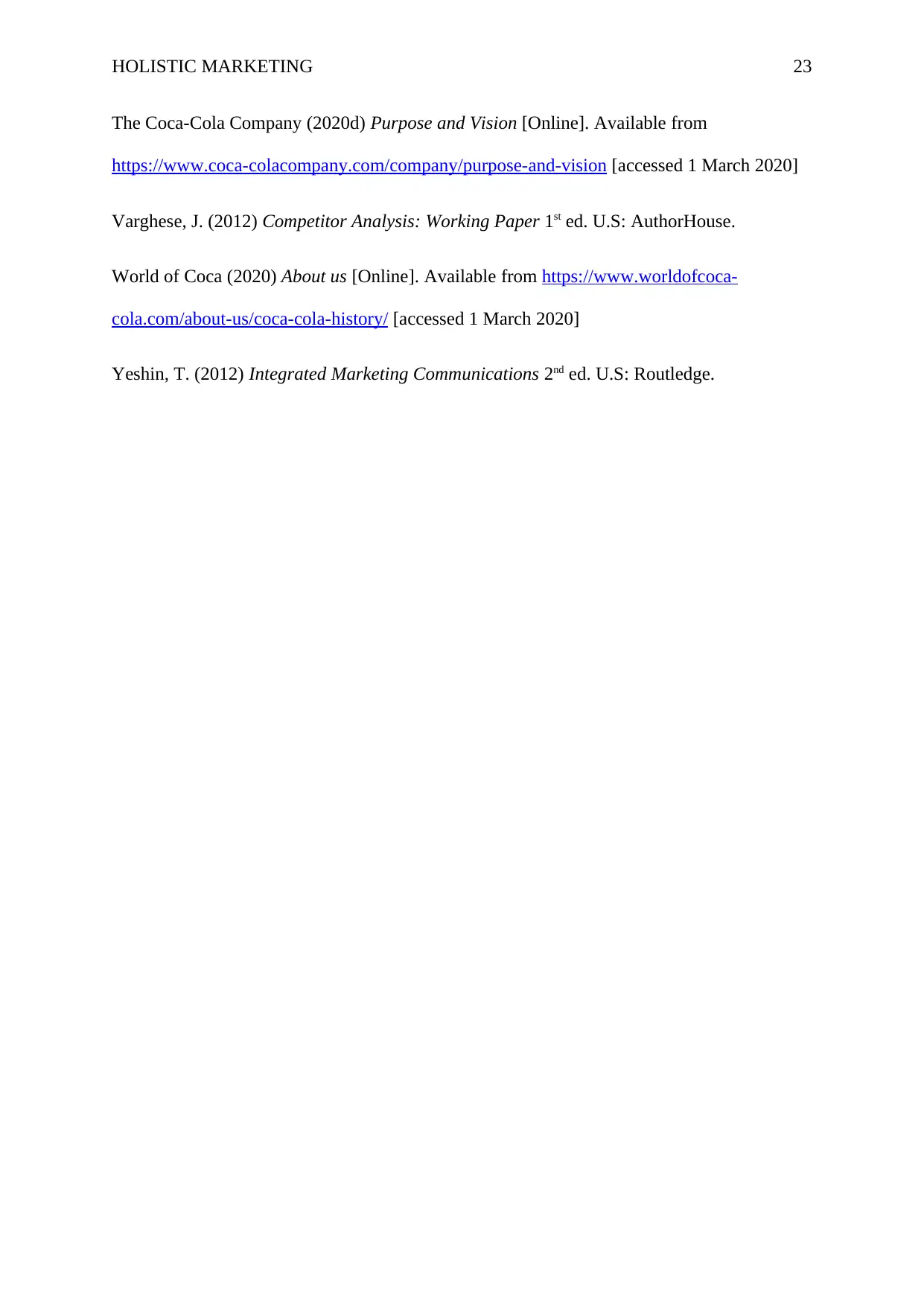
HOLISTIC MARKETING 23
The Coca-Cola Company (2020d) Purpose and Vision [Online]. Available from
https://www.coca-colacompany.com/company/purpose-and-vision [accessed 1 March 2020]
Varghese, J. (2012) Competitor Analysis: Working Paper 1st ed. U.S: AuthorHouse.
World of Coca (2020) About us [Online]. Available from https://www.worldofcoca-
cola.com/about-us/coca-cola-history/ [accessed 1 March 2020]
Yeshin, T. (2012) Integrated Marketing Communications 2nd ed. U.S: Routledge.
The Coca-Cola Company (2020d) Purpose and Vision [Online]. Available from
https://www.coca-colacompany.com/company/purpose-and-vision [accessed 1 March 2020]
Varghese, J. (2012) Competitor Analysis: Working Paper 1st ed. U.S: AuthorHouse.
World of Coca (2020) About us [Online]. Available from https://www.worldofcoca-
cola.com/about-us/coca-cola-history/ [accessed 1 March 2020]
Yeshin, T. (2012) Integrated Marketing Communications 2nd ed. U.S: Routledge.
1 out of 24
Related Documents
Your All-in-One AI-Powered Toolkit for Academic Success.
+13062052269
info@desklib.com
Available 24*7 on WhatsApp / Email
![[object Object]](/_next/static/media/star-bottom.7253800d.svg)
Unlock your academic potential
© 2024 | Zucol Services PVT LTD | All rights reserved.




